Samsung QN900D is undoubtedly the top model for 2024. This television is equipped with Mini LED technology, which provides excellent picture quality – deep blacks and high brightness make films and high-definition content look fantastic. During dynamic scenes in movies, colours and details were exceptionally well presented – especially after calibration. HDR also does not disappoint – bright elements have an excellent level of detail, and the colours are vibrant and natural. One of the strongest points of QN900D is motion smoothness. Supporting a refresh rate of 240 Hz at 4K resolution is rare on the market. Dynamic scenes in sports or games look incredibly smooth, without a trace of blurring. However, it should be added that only users of advanced PCs will fully utilise the capabilities of this feature. An input lag of 9 ms additionally ensures very responsive gameplay, which will certainly please gamers. Tizen operates smoothly and provides access to all popular applications, such as Netflix, YouTube, and Disney+. Moreover, SmartThings features and support for AirPlay allow easy connection of the television with other devices in the home. This is a great solution if you care about comfortably controlling your smart home. An additional perk is Ambient Mode – the television can blend into the décor of the living room by displaying decorative graphics. QN900D not only works well but also looks great. Slim bezels, a central stand, and the One Connect module that allows for cable concealment make the television look elegant. If aesthetics matter to us, it will be hard to find something better. As befits a flagship model, QN900D is simply expensive. Unfortunately, the lack of agreement between Samsung and Dolby Vision may still be a significant downside, especially when watching content on platforms that utilise this format. In the most demanding HDR scenes, it also happens that the contrast is not as perfect as we might expect. And what about 8K resolution? For now, it is difficult to find content that fully utilises it, unless we are enthusiasts for future technology. Samsung QN900D is certainly a television for those who are looking for a top-tier device and are willing to pay for it. However, if we are looking for similar quality at a considerably lower price, it is worth mentioning the equally good QN95D – it offers similar picture quality, without the 8K resolution, which is still more of a curiosity than a standard.
- Matching (Score)
- Our verdict
- TV appearance
- Where to buy
- Contrast and black detail
- HDR effect quality
- Factory color reproduction
- Color reproduction after calibration
- Smoothness of tonal transitions
- Image scaling and smoothness of tonal transitions
- Blur and motion smoothness
- Console compatibility and gaming features
- Input lag
- Compatibility with PC
- Viewing angles
- TV efficiency during daytime
- Details about the matrix
- TV features
- Apps
- Playing files from USB
- Sound
Samsung QN900D Neo QLED 8K vs Samsung QN85F
Direct compare
QN900D / Neo QLED / Excellence Line
QN85F

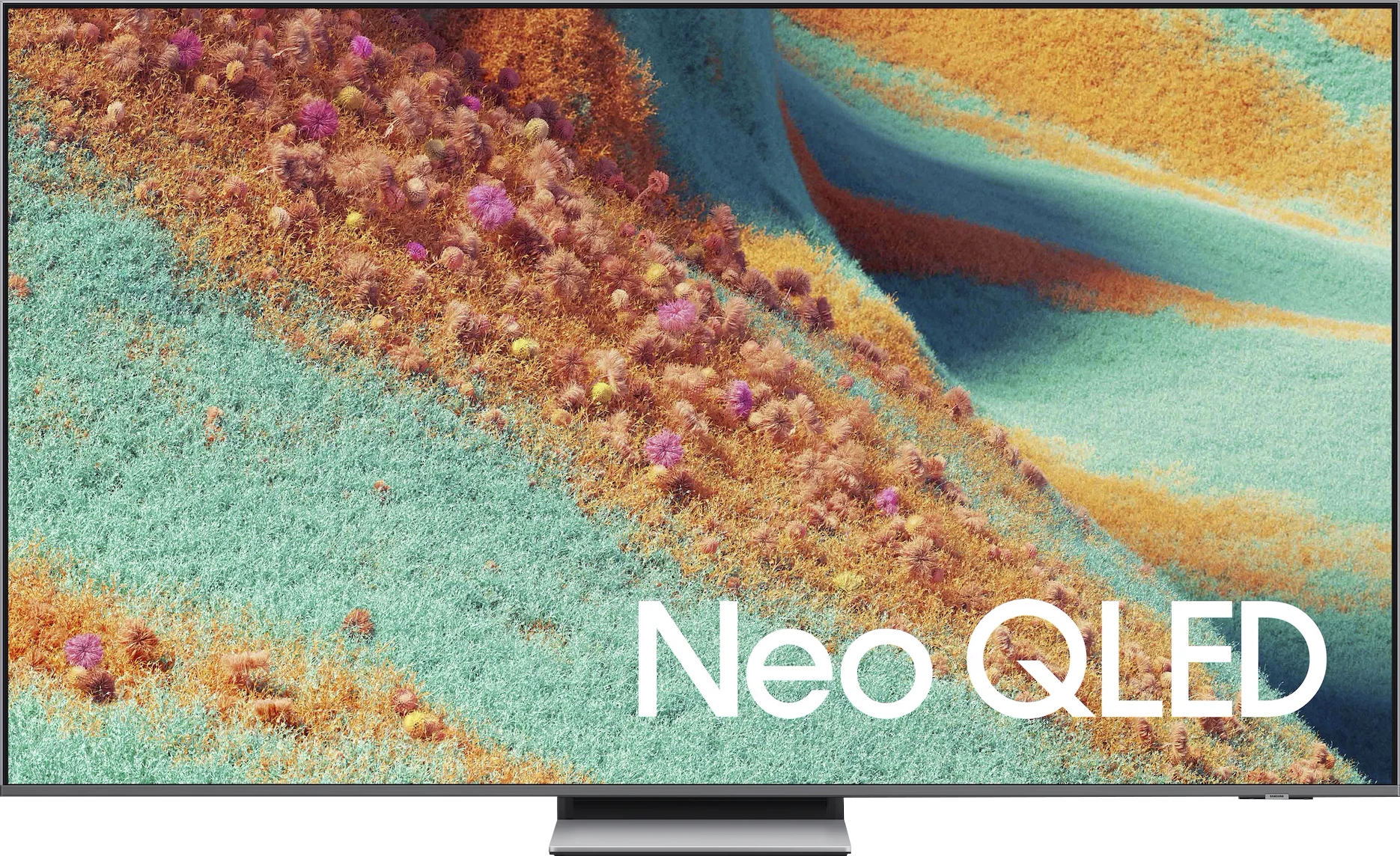
Panel type: LCD VA (wide viewing angle)
Resolution: 7680x4320
System: Tizen
Model year: 2024
Complete the survey to find out the result

Panel type: LCD VA
Resolution: 3840x2160
System: Tizen
Model year: 2025
Complete the survey to find out the result

Overall rating
7.5
7.6
Movies and series in UHD quality
7.6
7.5
Classic TV, YouTube
7.8
7.2
Sports broadcasts (TV and apps)
7.6
7.0
Gaming on console
9.0
8.7
TV as a computer monitor
8.0
8.4
Watching in bright light
5.0
6.9
Utility functions
7.4
7.3
Apps
8.7
8.7
Sound quality
7.4
7.6
Complete the survey to find out what fits your preferences
Advantages
Great contrast and blacks
High brightness - good HDR effect
The smoothest television in the world - 4K@240Hz
Excellent for gaming - low input lag, many features for gamers
Good digital processing - handles low-quality material well
Advanced operating system - Tizen
Great design - super slim, OneConnect, "floating" central stand
High HDR brightness (even 1700–1800 nits)
Very good contrast and deep blacks
2 times higher number of dimming zones than its predecessor (55")
144 Hz panel with VRR and ALLM support
Unique Game Motion Plus feature – a unique smoother for gaming
Low input lag
Matte screen finish works great during the day combined with high brightness
Advanced Tizen platform: with AirPlay, SmartThings and a convenient solar remote
Well-designed stand. Hybrid – can be a central base or side legs
Solid sound with pleasant bass and Dolby Atmos support
Disadvantages
Price
No Dolby Vision
No support for Dolby Vision and DTS:X
No recording function from built-in tuners and PiP
Issue with HEIC files in the player
No proper support for HGiG* in game mode
*This seems to be a bug in the update, which we hope Samsung will fix quickly. We are monitoring the situation for you on an ongoing basis.
Our verdict
The Samsung QN85F is a television that perfectly demonstrates the purpose of the Neo QLED line. On one hand, it offers everything that today's user expects – high brightness, excellent fluidity, and full support for gamers. On the other hand, it is still LCD, meaning it comes with certain compromises. The question is whether these compromises genuinely hinder everyday use. In practice, it is hard not to be impressed by how the QN85F performs in HDR films. With a brightness level of 1700–1800 nits, watching dynamic scenes truly delivers the "HDR spark" that is lacking in many competing televisions. The lighting effects in films or series can literally overwhelm with their intensity, yet the television maintains detail and doesn’t turn the entire image into a washed-out blur. This is the kind of spectacularity that viewers investing in a new screen are looking for. Gamers also have reasons to be pleased (well, except for one drawback related to HGIG). It supports 144 Hz, variable refresh rate VRR, and automatic low latency mode ALLM. This is already a standard set in this class, but Samsung goes further and adds a unique feature called Game Motion Plus. With it, the image in games becomes smoother, reminiscent of the operation of motion smoothing, but without a noticeable increase in lag. This solution truly distinguishes the QN85F from the competition. On top of all this comes daily convenience. The Tizen system is fast, stable, and filled with applications that we actually use – from Netflix to Apple TV, and even YouTube and Disney+. Additionally, it supports AirPlay, has a comprehensive SmartThings platform, and the remote control, instead of overwhelming us with dozens of buttons, provides simple navigation and quick access to the most important features. This makes the QN85F a television that one simply wants to reach for on a daily basis. Indeed, one could highlight its shortcomings. There is no Dolby Vision, no USB recording, nor Picture-in-Picture, and the viewing angles typical of VA panels won't impress if you sit at a large angle. But all of this pales in comparison to how versatile and refined the QN85F is. During the day, it performs excellently in bright rooms; in the evening, it provides cinematic emotions in HDR, while in games it ensures fluidity and low input lag that other models would envy. Overall, the QN85F is a television that not only successfully continues the value-for-money tradition of its predecessor, the QN85D, but also expands it with several strong points. It is a piece of equipment that is hard to describe as anything other than a "safe choice" – one that will not disappoint in any scenario and is likely to meet the expectations of even the most demanding users.
TV appearance





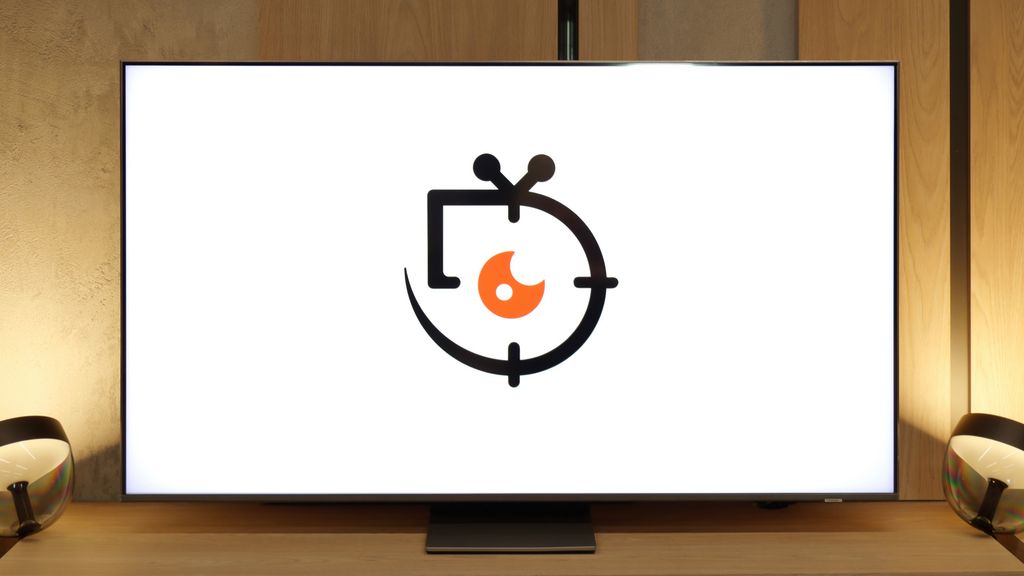
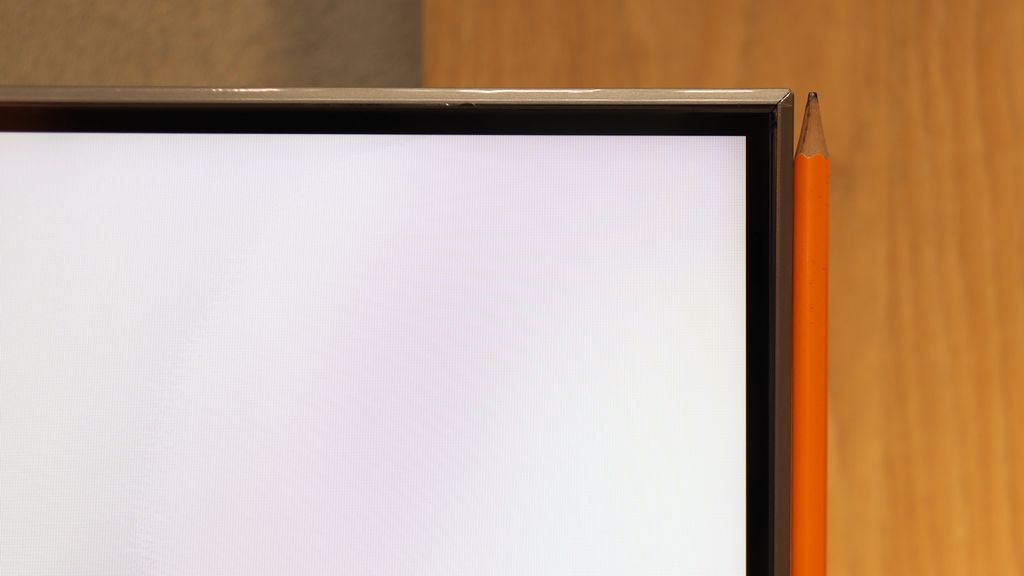
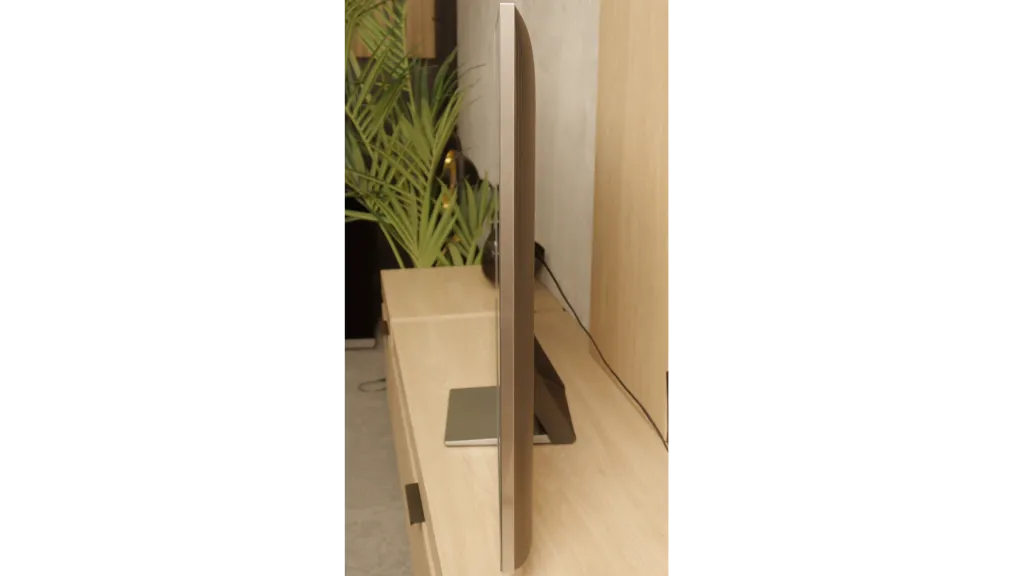
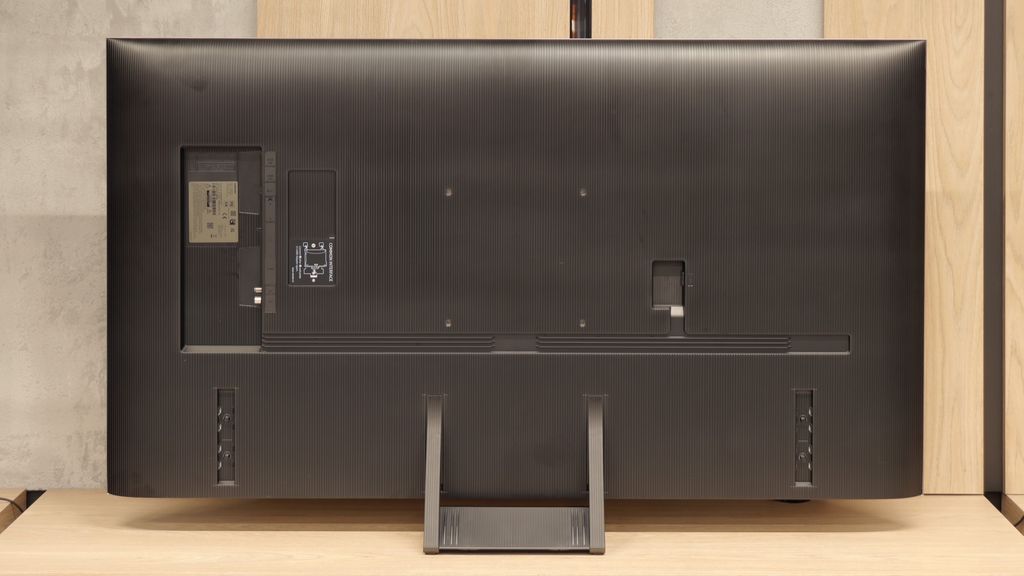
Contrast and black detail
8/10
7.5/10
Local dimming function: Yes, number of zones: 1344 (56 x 24)
Local dimming function: Yes, number of zones: 240 (20 x 12)
Contrast:

Result
∞:1

Result
205,000:1

Result
89,000:1

Result
7,800:1

Result
4,000:1

Result
101,800:1

Result
18,650:1

Result
47,050:1

Result
9,700:1

Result
4,350:1
Halo effect and black detail visibility:

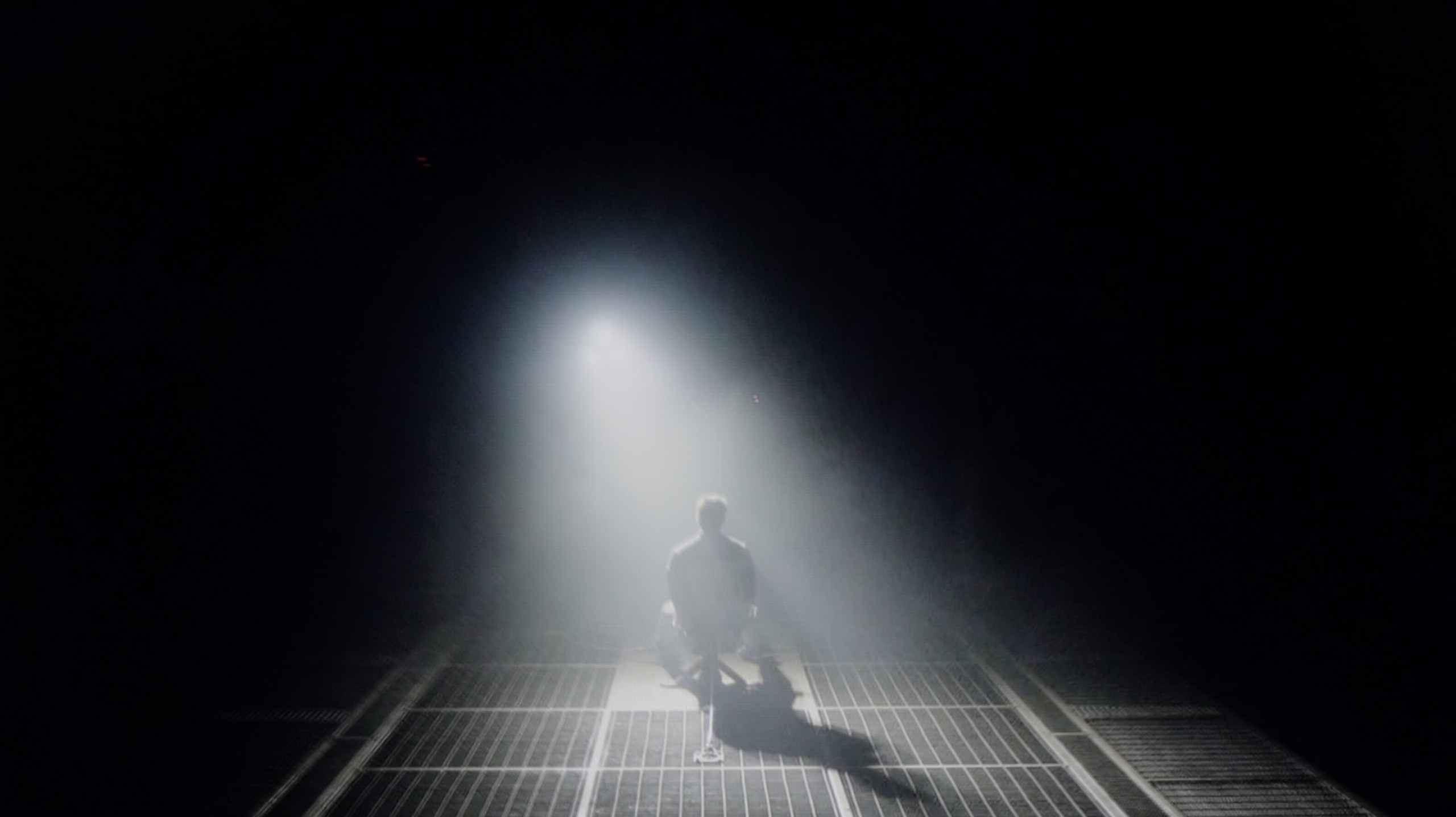
As befits the top model in the series, the Samsung QN900D television is equipped with a VA panel, which in the 65-inch version offers an impressive number of zones – as many as 1344. It is worth noting that larger sizes of this television have an even greater number of zones, which naturally translates to better contrast. During tests in scenes from the film "Oblivion," the QN900D performs excellently. Contrast values close to infinity are truly impressive, allowing for bold comparisons between this television and OLEDs. Unfortunately, like every LCD television, this model also has its limitations. In the case of very small elements, certain inaccuracies are visible, such as halo effects (e.g., in the film "Sicario 2") and occasionally significant dimming of the screen (e.g., in scenes from the film "Gravity"). Despite these imperfections, the Samsung QN900D is undoubtedly one of the best LED televisions available on the market, capable of generating very high contrast.
Our editorial office received a 55-inch model with a VA panel. In the case of NeoQLEDs, which are televisions with Mini-LED backlighting, size is of immense importance, as the larger the screen, the more local dimming zones it can contain. This directly translates to higher contrast. In the variant we tested, we counted as many as 240 dimming zones, which is twice as many as last year's QN85D. Theoretically, such an increase should bring an equally impressive improvement in contrast. Unfortunately, practice showed something different – the QN85F offers results very similar to its predecessor. Indeed, in certain scenes with a lot of black or in areas where details in the highlights are crucial, you can see progress, but it is not proportional to the number of zones themselves. Mini-LED technology can be capricious, and sometimes a slight halo appears around small bright objects. This is a typical compromise one must accept with such a solution. Nevertheless, the contrast in the QN85F is at a very high level and will comfortably satisfy most users, even those who are more demanding. However, we have the impression that Samsung could refine the algorithms controlling the dimming, as we know from experience that they can perform exceptionally well in other models.
HDR effect quality
6.6/10
6.9/10
Luminance measurements in HDR:

Result
1447 nit

Result
665 nit

Result
907 nit

Result
432 nit

Result
793 nit

Result
1248 nit

Result
860 nit

Result
1093 nit

Result
465 nit

Result
957 nit
Scene from the movie “Pan” (about 2800 nits)


Scene from the movie “Billy Lynn” (about 1100 nits)


Static HDR10


Dynamic: HDR10+
Dynamic: HDR10+


HDR luminance chart:
Samsung QN85F
HDR luminance
Samsung QN900D Neo QLED 8K
HDR luminance
The Samsung QN900D television demonstrates its high capabilities in light production in synthetic tests without any issues – 1400 nits is truly an impressive figure. It also showcased these capabilities in the first scene from the film "Life of Pi," where we see a brilliant burst of the rising sun. However, due to problems with the dimming algorithm, some issues can be noticed here. In the test scenes from "Sicario 2" and the second scene from "Life of Pi," these values are no longer as high and amount to around 500-600 nits. While this may not be the worst result among Mini LED televisions, one could expect more given the price of the television. Nonetheless, the television deserves praise for covering a wide colour gamut of DCP P3 at 96%. Although there are technologies offering higher values, this result is still satisfactory.
Although more than twice the number of dimming zones compared to its predecessor did not translate into a spectacular jump in black levels and contrast, we definitely felt it in the HDR effect itself. The QN85F is up to 50% brighter than last year's model, making a huge impression in dynamic scenes. The peak brightness can reach almost 1700–1800 nits, which is truly impressive for Mini-LED in this class. The best part is that almost regardless of the scene being watched, the HDR effect remains strong and vibrant. In four out of five test scenes, brightness was maintained around 1000 nits, a level that in most cases allows the viewer to experience the true magic of this format. Of course, in scene number 4 from the film Sicario 2, the limitations of Mini-LED technology become apparent – the brightness of the helicopter’s small light drops to around 500 nits. This result is not stellar, but it is still much more acceptable than last year's model. Samsung therefore deserves applause, as the improvement in brightness in the QN85F is drastic compared to its predecessor. However, it is a shame about a certain trend visible in this year's televisions – the manufacturer has worsened the colour gamut coverage. Although the QN85F has a QLED panel, its score of around 90% DCI-P3 is average, and in the most demanding films, it can lead to less vibrant colours than its predecessor. Despite this shortcoming, the overall HDR effect stands at an excellent level and truly makes a big impression in this class of devices.
Factory color reproduction
6.6/10
4.8/10


Factory Mode
After calibration


Factory Mode
After calibration
The television QN900D offers a Filmmaker mode that has been created with the intention of watching films in the most natural way possible, however, this mode is not without certain flaws. For HD content, the white balance shows a dominance of red and blue colours, causing the image to take on pink hues. In contrast, for 4K HDR content, the situation is the opposite – the decrease in blue and red levels warms up scenes and shifts colours towards yellow tones. This is confirmed by Color Checker tests, which clearly show that colour samples are veering in this direction.
As for brightness and the associated contrast, the gamma is significantly impaired. The biggest issue is a noticeable jump at the beginning of the graph, which indicates that dark details are excessively brightened, resulting in a loss of depth in the darkest areas of the image – this is due to local dimming. For 4K HDR materials, the EOTF curve looks quite good, however, it remains below the reference level, impacting the overall dynamics of the image.
Samsung QN85F offers several preset picture modes, but by default, when the television is turned on, it starts in "Eco" mode. And we could actually end the discussion here, because for such a model, using this setting makes no sense – the picture is washed out, unpleasant, and far from what we expect from a television of this class. We therefore carried out our tests in the best of the available modes, which is the Filmmaker mode. Its purpose is to faithfully reproduce what the directors saw during the filming of the movies, and indeed this is the setting that performs best among all factory options. However, this does not mean that it is without flaws.
Both in SDR and HDR, the QN85F quite strongly emphasised warm colours. This resulted from deficiencies in white balance, where there was a distinct lack of blue. Additionally, the picture was sometimes overexposed – as indicated by both the gamma brightness characteristic and the EOTF curve, which showed that the television tends to blow out scenes. In SDR, the colour reproduction errors (Delta E levels of 4-5) were still acceptable, but in HDR the discrepancies became quite large and clearly deviated from what the creators intended to show us. Fortunately, Samsung provides a wide range of calibration tools in its televisions, so – as always – we proceeded with professional calibration to see how much could be improved.
Color reproduction after calibration
8/10
8.5/10




After calibration, the Filmmaker mode can indeed be called worthy of its name. The white balance for both HD and 4K HDR content has been significantly improved, making colours more natural and consistent. The image has gained in realism, and pink hues in HD content have been effectively eliminated, as has the yellowish glow in 4K HDR content. Thanks to calibration, the television now offers much better colour reproduction, positively affecting the viewing experience.
As for brightness, the situation with gamma is now quite the opposite – at the beginning of the graph, there is a noticeable drop, making the darkest details harder to discern. The EOTF curve for 4K HDR content has remained largely unchanged and is still below the reference level, meaning the television still struggles to maintain proper brightness. This is related to the aggressive dimming algorithm that affects the overall brightness of the image. You can see how the television fights to maintain high brightness or perfect black.
Despite the limitations associated with local dimming, the Samsung QN900D has improved colour reproduction quality, as confirmed by the Color Checker test results – the colour samples are now much closer to the targets, making the image more natural and pleasing to the eye.
After calibrating the film mode, we managed to tame the colours in both modes to near perfection – most of them did not exceed an error value of 3, which is the threshold of perception by the human eye. The image became more natural, fuller, and at the same time free from bloom, which was noticeable right after taking the television out of the box. This shows the great potential of the QN85F and how well it responds to precise settings. However, this does not change the fact that certain technological barriers cannot be overcome. Despite the enormous benefits of calibration, there are still limitations of the panel itself. Although the number of dimming zones has doubled compared to its predecessor, the algorithms controlling the backlighting can manipulate brightness in their own way. Sometimes this leads to slight colour inaccuracies or gently visible halo effects around bright objects. Nevertheless, the experience after calibration is truly pleasant and demonstrates how good a screen the QN85F can be if we just take a moment for proper settings.
Smoothness of tonal transitions
8/10
9/10

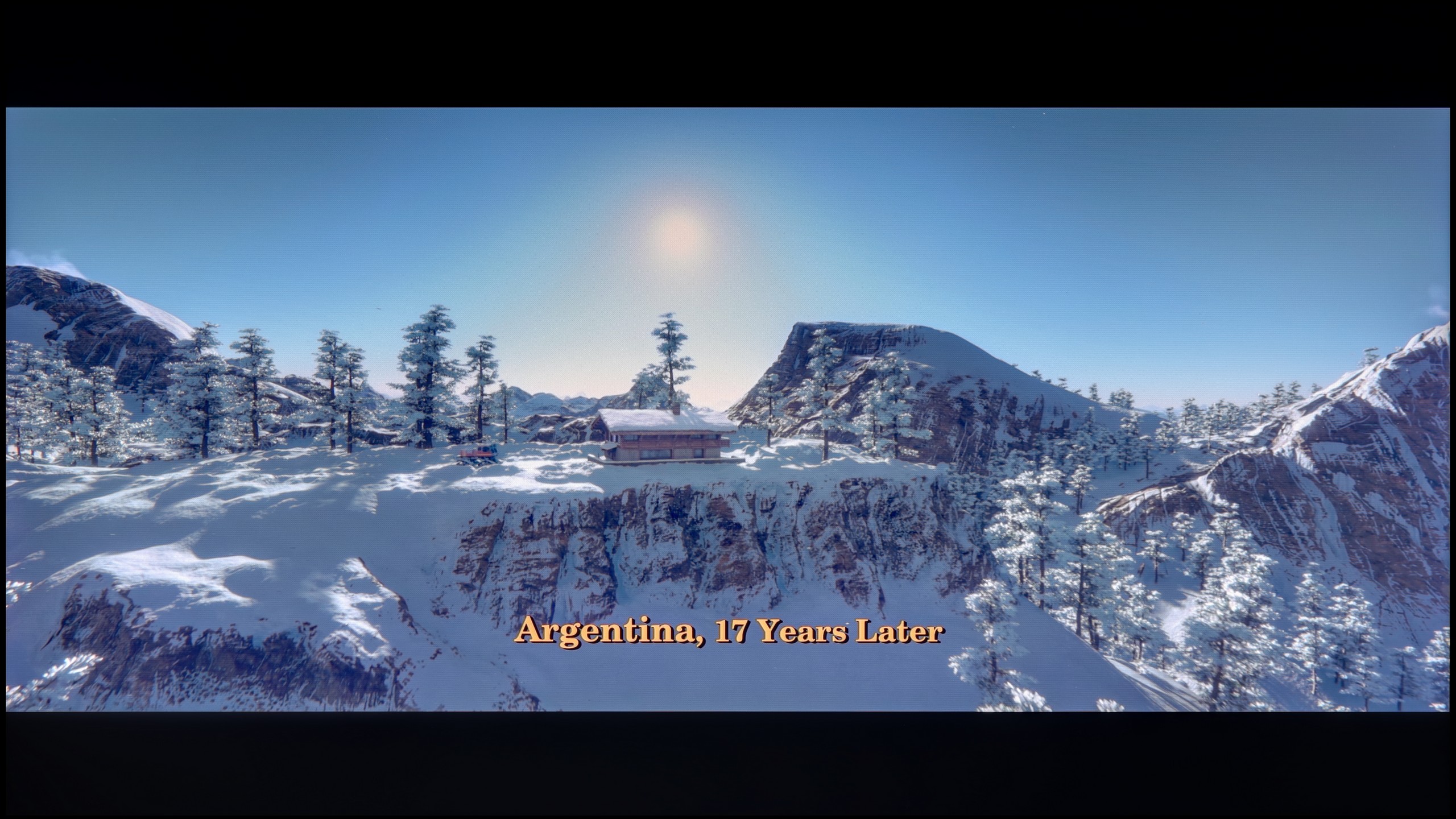










The Samsung QN900D television handles tonal transitions smoothly, deserving a rating of 8/10. Colour gradation is generally good, although not perfect – in darker scenes, certain imperfections may be noticeable to more demanding users. Despite these minor flaws, the effect should satisfy most viewers, providing natural transitions.
Slight colour errors are often practically unnoticeable; it is the fluidity of tonal transitions that is a category to which even a less experienced viewer will pay attention. Unfortunate bands and artificial lines can completely spoil the perception of the image. Fortunately, the QN85F handles this aspect almost perfectly. Gradients are smooth, transitions between colours seamless, and there are no artificial streaks or harsh lines separating the hues on the screen. The image remains coherent, and nothing distracts our attention from the content. Only under very extreme conditions did we notice slight issues in the grey palette, but this is a drawback typical of most televisions and is hard to consider a serious negative. In practice, while watching films, we encountered no problems.
Image scaling and smoothness of tonal transitions
7/10
7.5/10
Smooth transition function

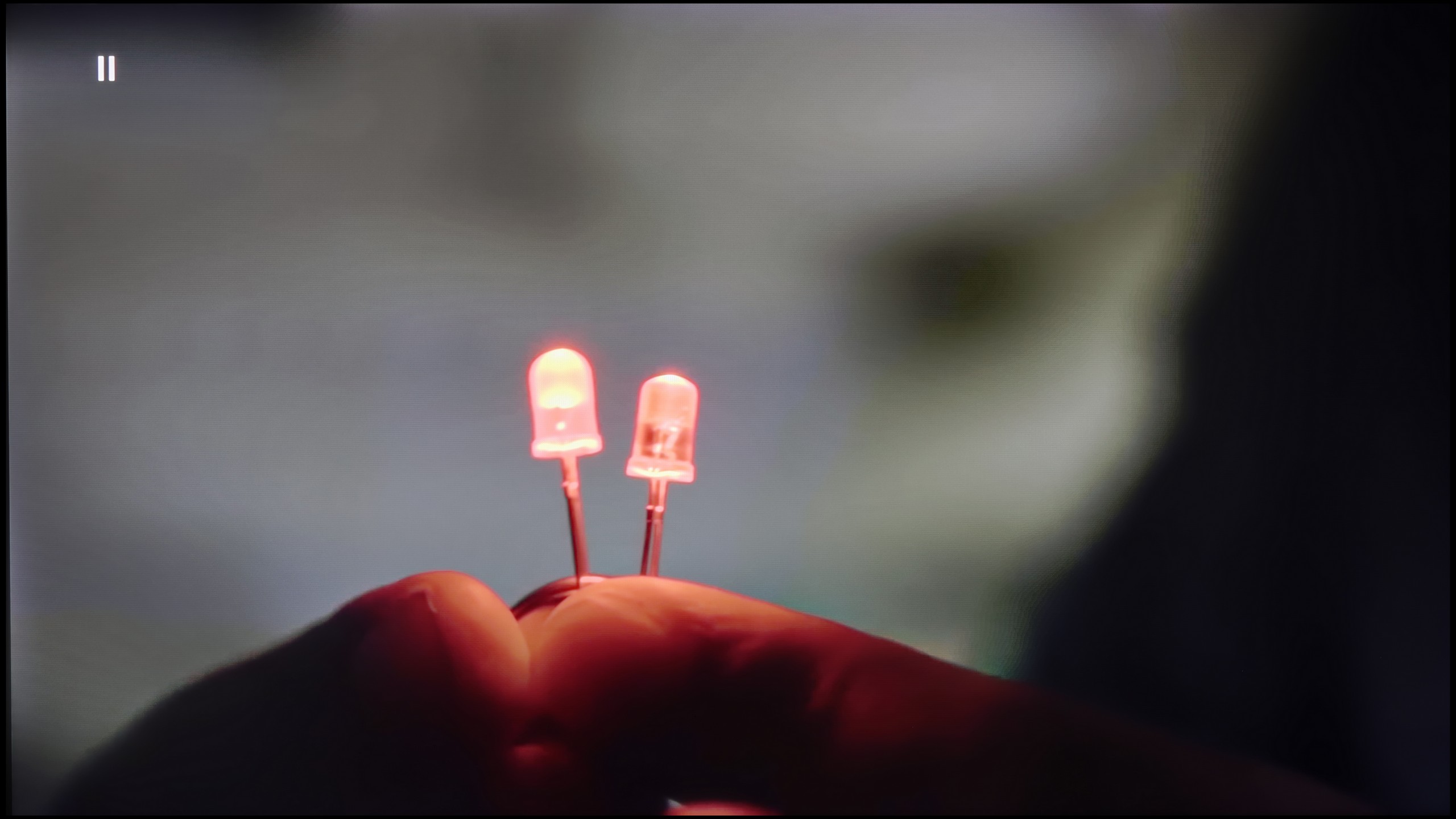
Image without overscan on the SD signal


The fluidity of tonal transitions in lower-quality materials is impressive – the Noise Reduction feature effectively smooths tonal transitions while eliminating film grain. Although the removal of grain is not always desirable, the overall final effect looks very aesthetically pleasing, particularly for those who prefer a cleaner image.
When it comes to upscaling, or image scaling, QN900D shows the enormous potential of the new processor with AI technology. Images and materials in lower resolution are upscaled while preserving many details – for example, a photo of a model looks fantastic, free of unnecessary jagged edges, and the branches in the background are not overly jagged.
Although the native tonal transitions on the QN85F with 4K material perform excellently, we do not always deal with content in the highest resolution. At that point, it becomes crucial how the television handles upscaling and digital image processing. This process is managed by Samsung's proprietary processor – AI NQ4 Gen2. In practice, it operates very efficiently. If visible colour banding or other undesirable phenomena occur on the screen, for instance, in materials from YouTube, they can easily be smoothed out using the "noise reduction" feature. Set to a medium level, it improves tonal transitions without excessively blurring desired details. However, it is important to remember that – as with most Samsung televisions – this function heavily interferes with the film grain. Therefore, during cinematic screenings, it is wise to use it cautiously to avoid losing the natural character of the image.
The upscaling itself looks very good. Test materials in lower resolutions were displayed sharply and clearly, with a great deal of detail. The only downside remains the issue of overscan, which is the trimming of the edges of the screen. In most situations, this is not noticeable, but with very old materials below HD quality, there may be cases where a fragment of the image from the left side gets slightly cut off.
Blur and motion smoothness
7.4/10
7.7/10

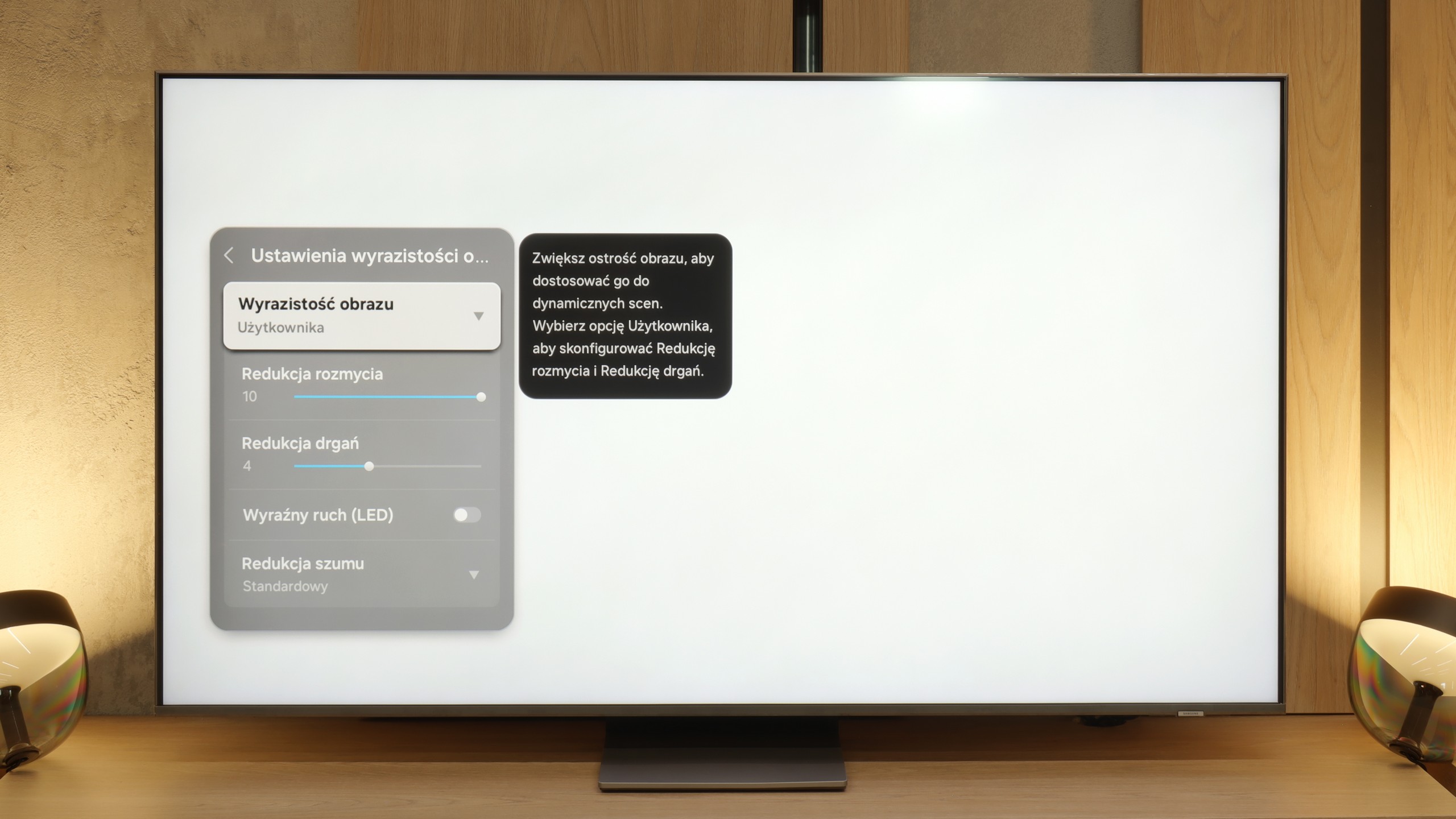
Blur (native resolution, maximum refresh rate):



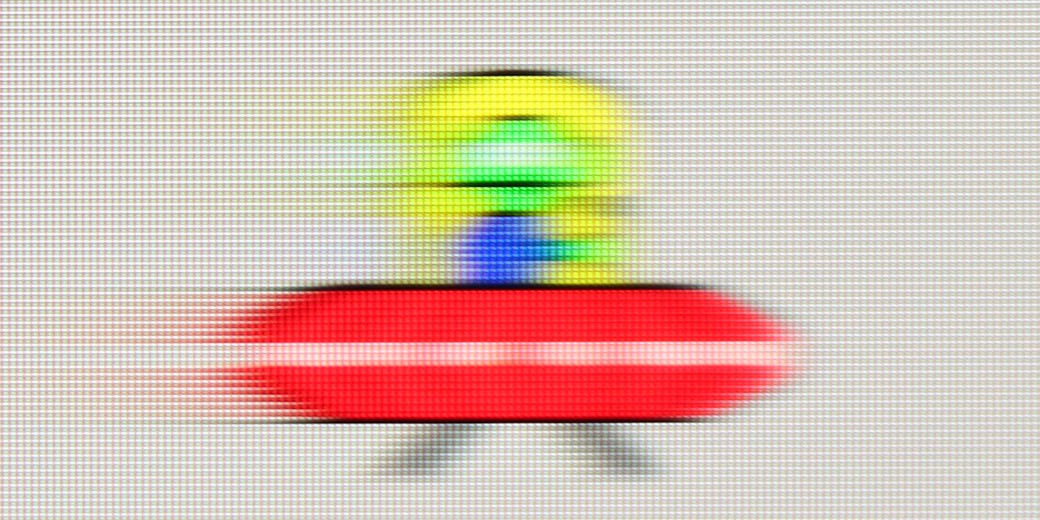
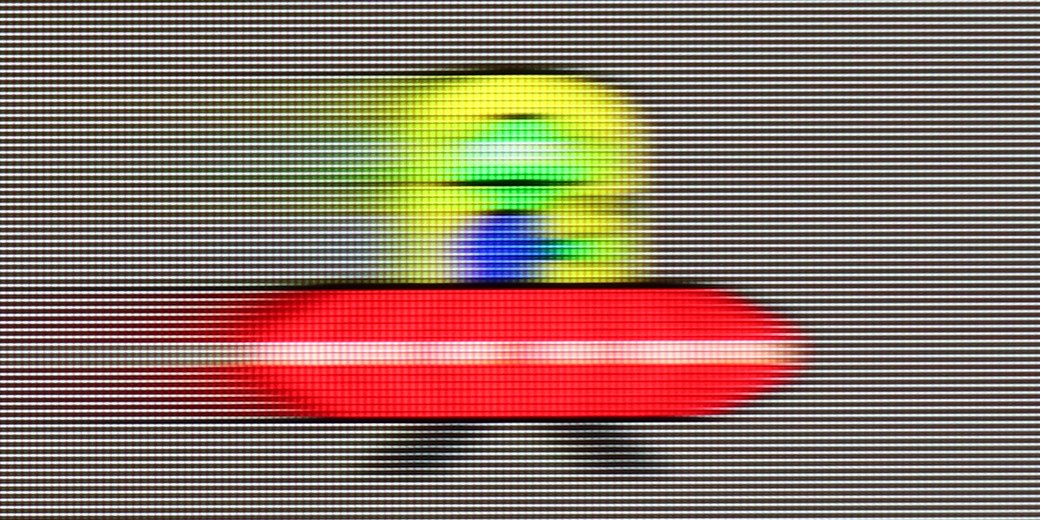
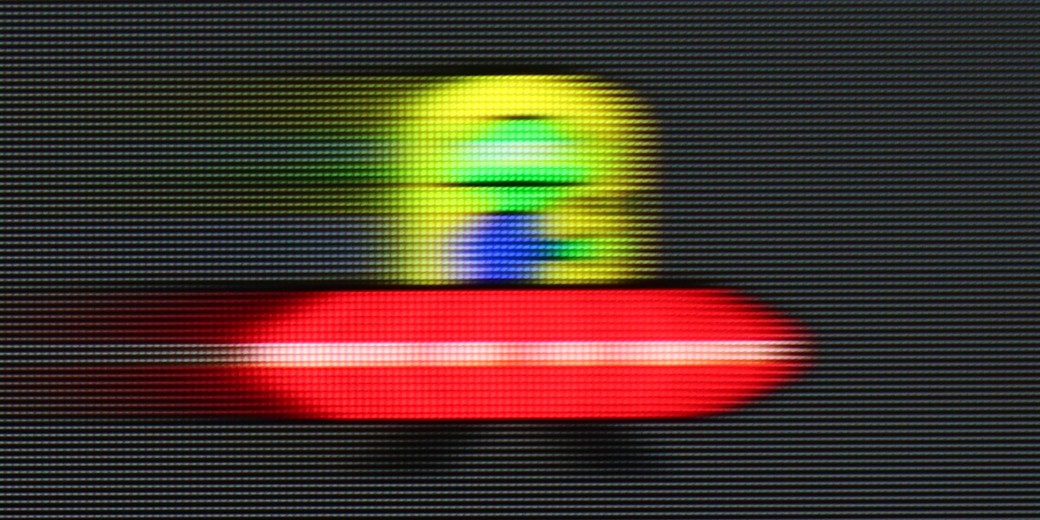
Blur (BFI function enabled):
Image flickers in this mode
Image flickers in this mode



Smużenie (2160p 240Hz):



Smużenie (4K@144Hz):

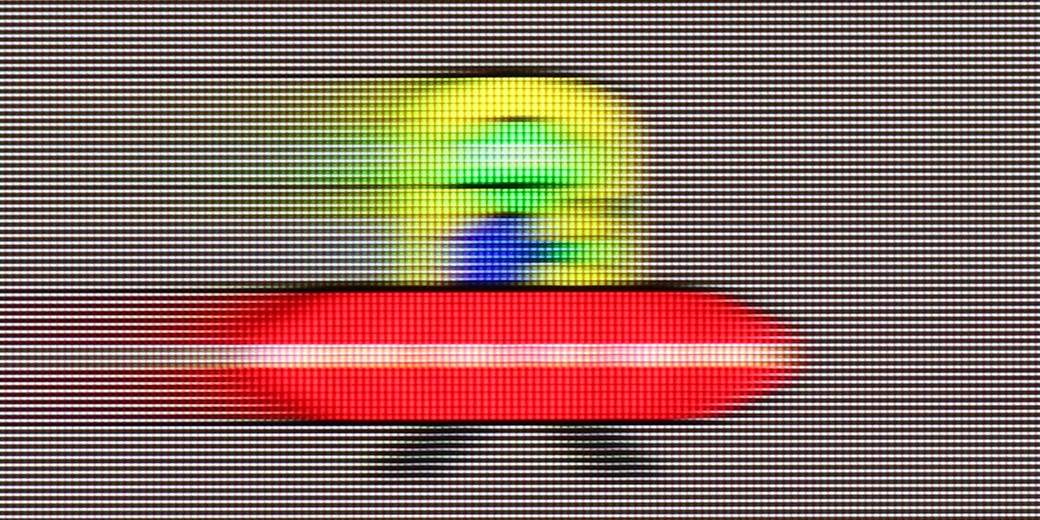
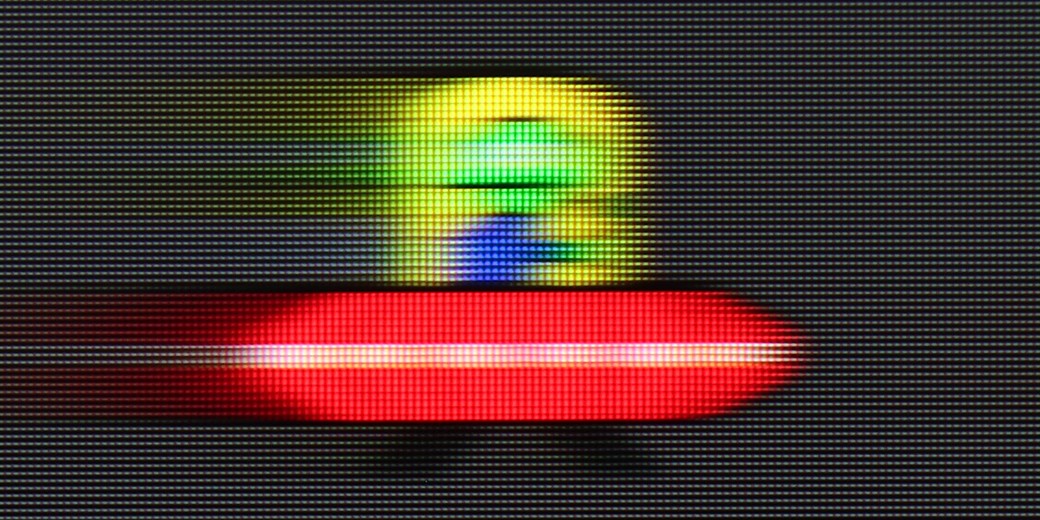
Samsung QN900D is currently the fastest television in the world – literally. A refresh rate of 240 Hz in 4K resolution is an incredible value that PC gamers will surely appreciate. As for cinema fans, they will not be disappointed either – Samsung offers a 10-step clarity scale in the picture settings, allowing for image adjustments. We can choose whether the television should provide a smoother, theatrical effect at the highest settings, or a more cinematic experience, with visible frames, at the lowest settings.
Motion smoothing and fluidity in the QN85F is a topic worth discussing in more detail, as the television is equipped not with a standard 120 Hz panel, but with a 144 Hz one. The extra hertz will mainly be appreciated by PC gamers, but the mere presence of such an option can be seen as a nice addition and a sign of the times – it’s hard to complain about the trend towards faster panels, as in practice, each of us would prefer the image to be as smooth as possible. However, the most important thing is how the television handles typical 120 Hz refresh rates – in the case of consoles, sports, or films recorded at 24 or 30 frames per second. Here, the QN85F performs really well. In films, one can easily adjust the character of the image thanks to the "image clarity" function, where we find two adjustable sliders. Key for screenings is the one responsible for reducing judder. Lower values give the image a more cinematic character with preserved "frame rate," while higher values lead to strong smoothing reminiscent of television theatre.
Console compatibility and gaming features
9.5/10
8.2/10
- ALLM
- VRR
- VRR range48 - 240Hz48 - 144Hz
- Dolby Vision Game Mode
- Correct implementation of HGIG
- 1080p@120Hz
- 1440p@120Hz
- 4K@120Hz
- Game bar

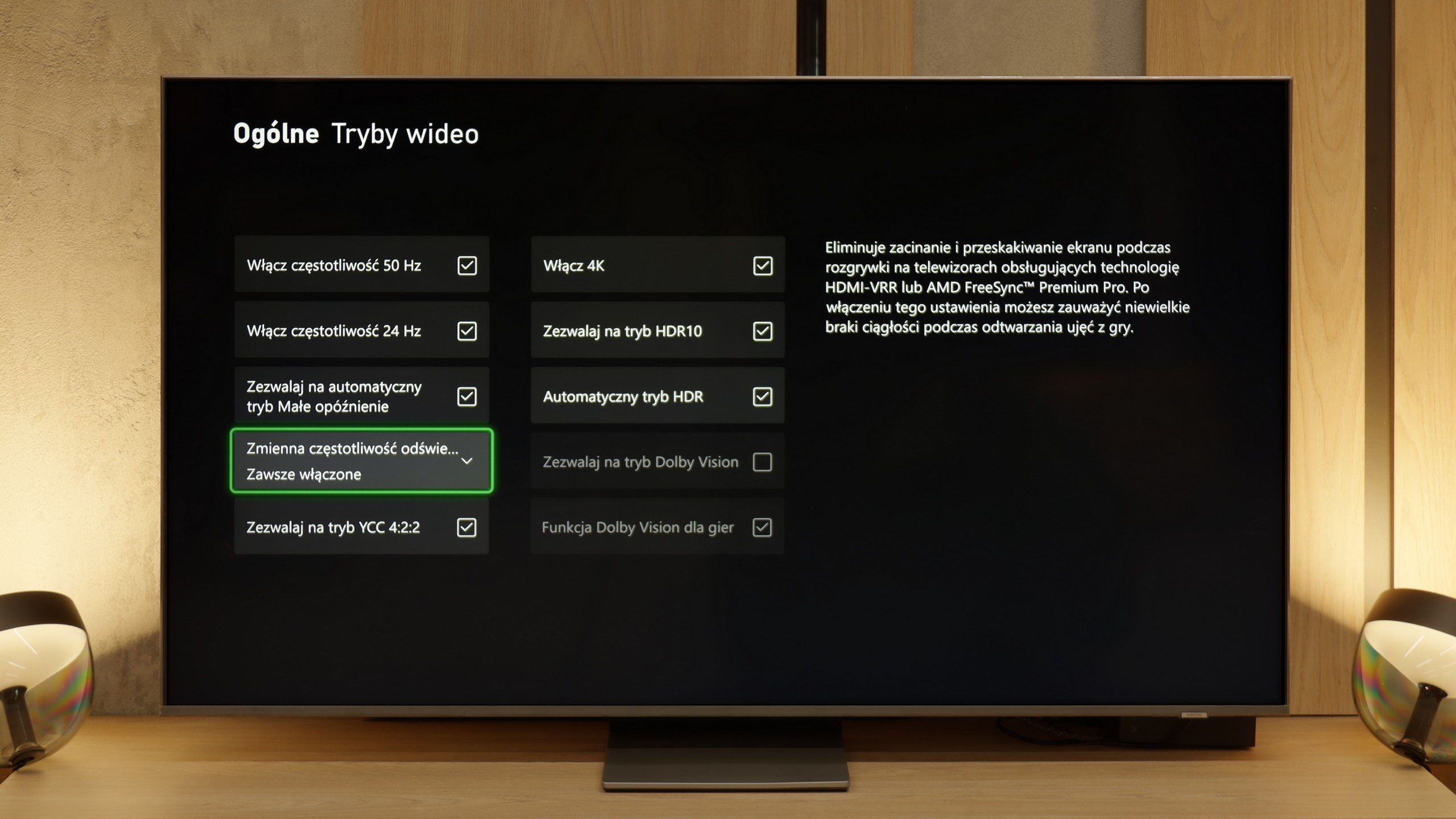

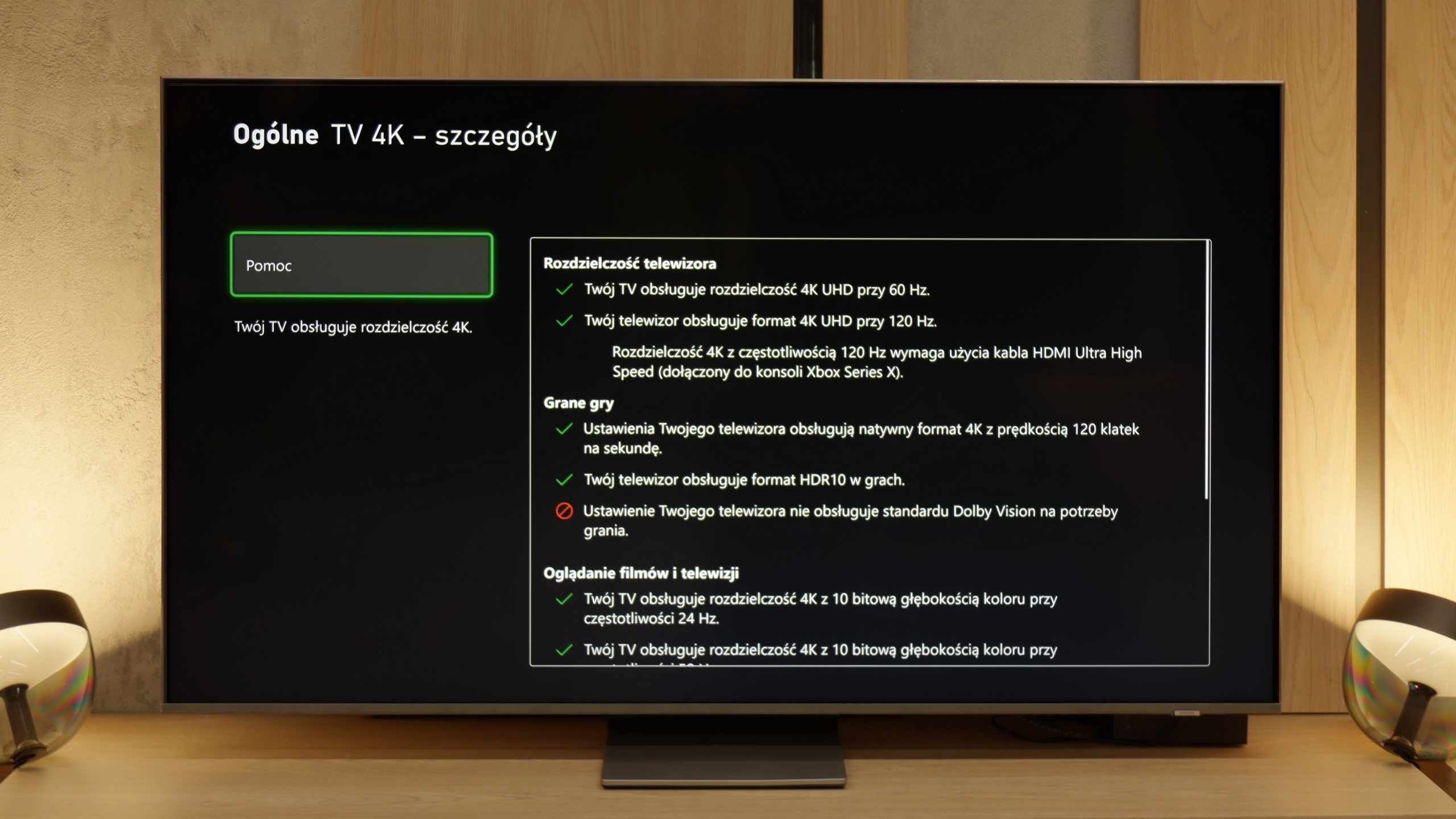

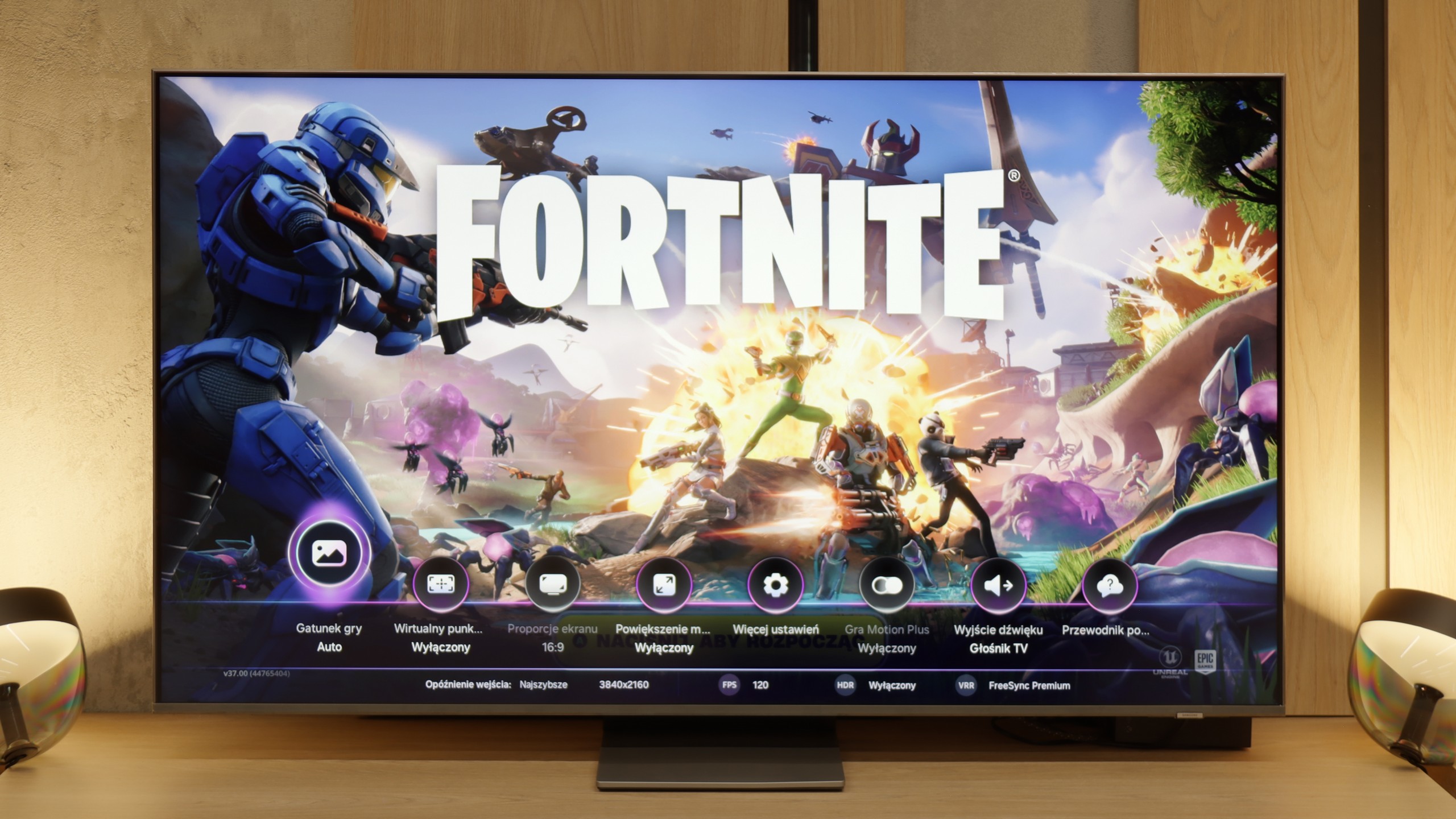

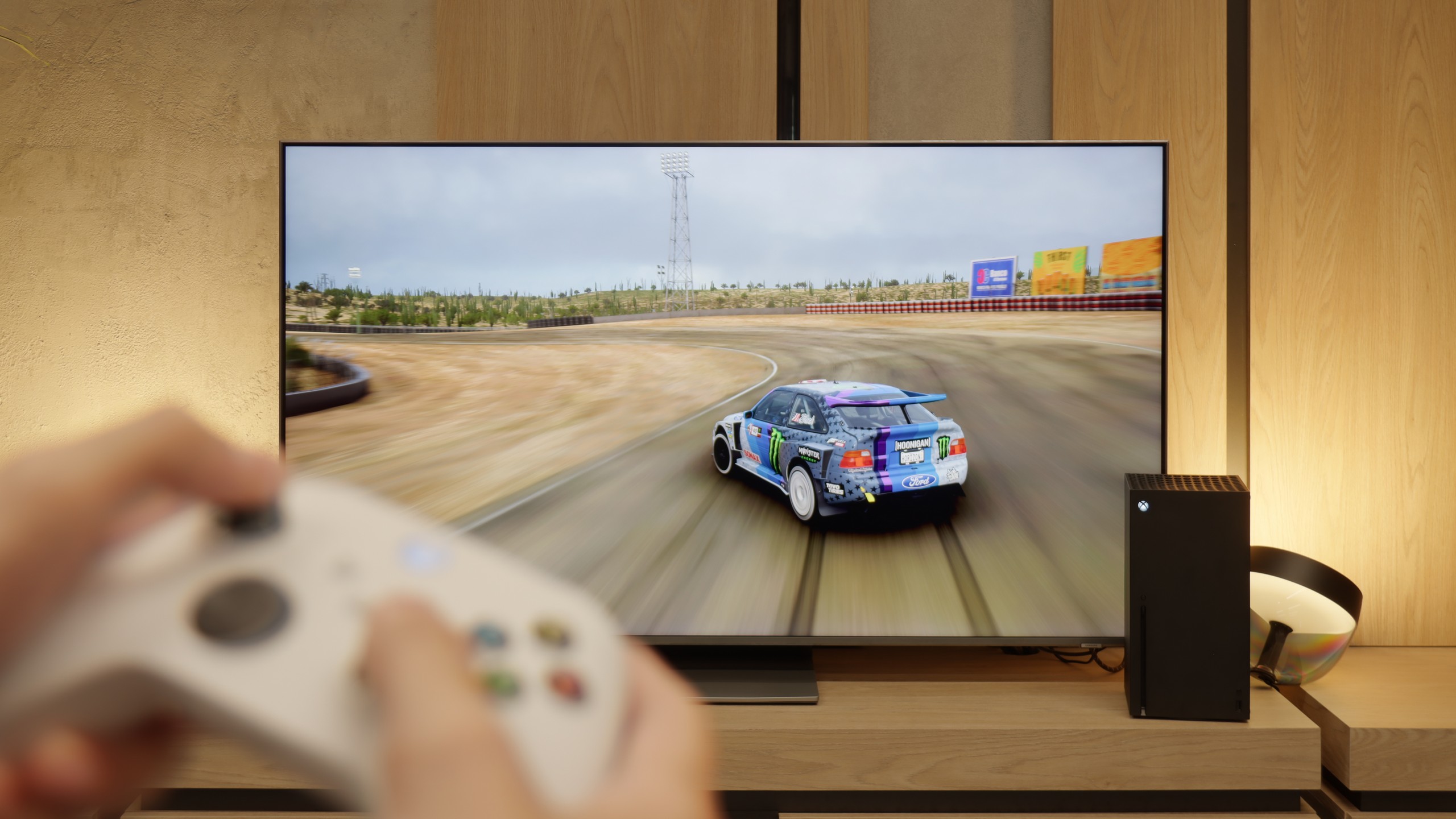
Samsung QN900D is a television that offers excellent compatibility with consoles and a range of features that gamers will appreciate. It has 4 HDMI 2.1 ports, although unfortunately without the full bandwidth of 48 Gb/s. Nevertheless, for the average user, this is more than sufficient. Additionally, the television supports Auto Low Latency Mode (ALLM) and Variable Refresh Rate (VRR), which means a smoother image and no screen tearing during dynamic gameplay. The G-Sync and FreeSync technologies also deserve attention, as they ensure optimal cooperation with consoles and computers equipped with the appropriate graphics cards, minimizing stuttering and providing a smooth image.
One of the unique features available only in Samsung televisions is the Xbox Game Pass app, which allows for game streaming without the need for a console. This is a very convenient solution that lets you enjoy your favourite games without the need to purchase additional hardware. Furthermore, the QN900D has a Game Bar – a special panel that enables quick access to game-related settings, making the configuration of game mode fast and intuitive.
Another interesting feature is a function called Auto Motion Plus Game, which is a special motion smoothing mode that can increase the frame rate (operating at a maximum for a 4K@60Hz signal). Importantly, this does not cause a significant increase in input lag, allowing the player to enjoy both greater image smoothness. All these features make the Samsung QN900D an excellent choice for those looking for a gaming television with the highest possible specifications.
The Samsung QN85F makes a really great impression from the perspective of gaming features. We have four HDMI 2.1 ports here, so we can easily connect several devices simultaneously. There is also variable refresh rate (VRR) to prevent screen tearing, as well as automatic low latency mode (ALLM), which allows the TV to switch to the appropriate settings when we start the console. Additionally, it supports refresh rates of up to 144 Hz – something that PC gamers will particularly appreciate, but the mere fact that such an option is available shows that Samsung is committed to full support for gamers. The Game Bar panel also deserves praise. It provides a quick overview of key parameters – from frame count to refresh mode, right down to shortcuts for picture settings. Instead of digging through the entire menu, everything is at our fingertips, which turns out to be really convenient in practice. However, the most interesting addition is the Game Motion Plus feature. This is nothing more than a motion smoother brought into the gaming world. When turned on, the image becomes smoother, sometimes appearing as if we’re getting several more frames, and importantly – the response time doesn’t increase sufficiently to hinder gameplay. This is a solution that truly distinguishes Samsung's 120Hz televisions from the competition.
The only serious downside remains the lack of proper HGiG support. This is the standard responsible for proper tone mapping in HDR games, ensuring that brightness and contrast are displayed according to the creators' intentions. Without HGiG, we have to adjust the brightness manually, which doesn’t always result in the ideal outcome. The feature was available in previous models, but it disappeared in the QN85F after one of the updates. We hope that Samsung will quickly address this issue, and we will be monitoring whether it has been resolved.
Input lag
9.8/10
9.8/10
SDR
HDR
Dolby Vision
When it comes to signal delay (input lag), Samsung QN900D achieves impressive results. Values below 15 ms are truly excellent, making the television an ideal choice for gamers expecting minimal delays during gameplay. The input lag at 8K resolution is also noteworthy, measuring just 17 ms – this is also a very good result that allows enjoyment of dynamic games at the highest possible resolution without noticeable delays.
The input lag on the QN85F is at a very high level. With content at 120 or 144 Hz, the values often oscillated below 10 ms, which is a truly remarkable result. Naturally, when gaming at 60 Hz, the lag doubles, but it still remains low enough that in practice it is virtually unnoticeable. This means that the QN85F will perform well both in dynamic e-sports games and in more tranquil console titles.
Compatibility with PC
8/10
8.4/10

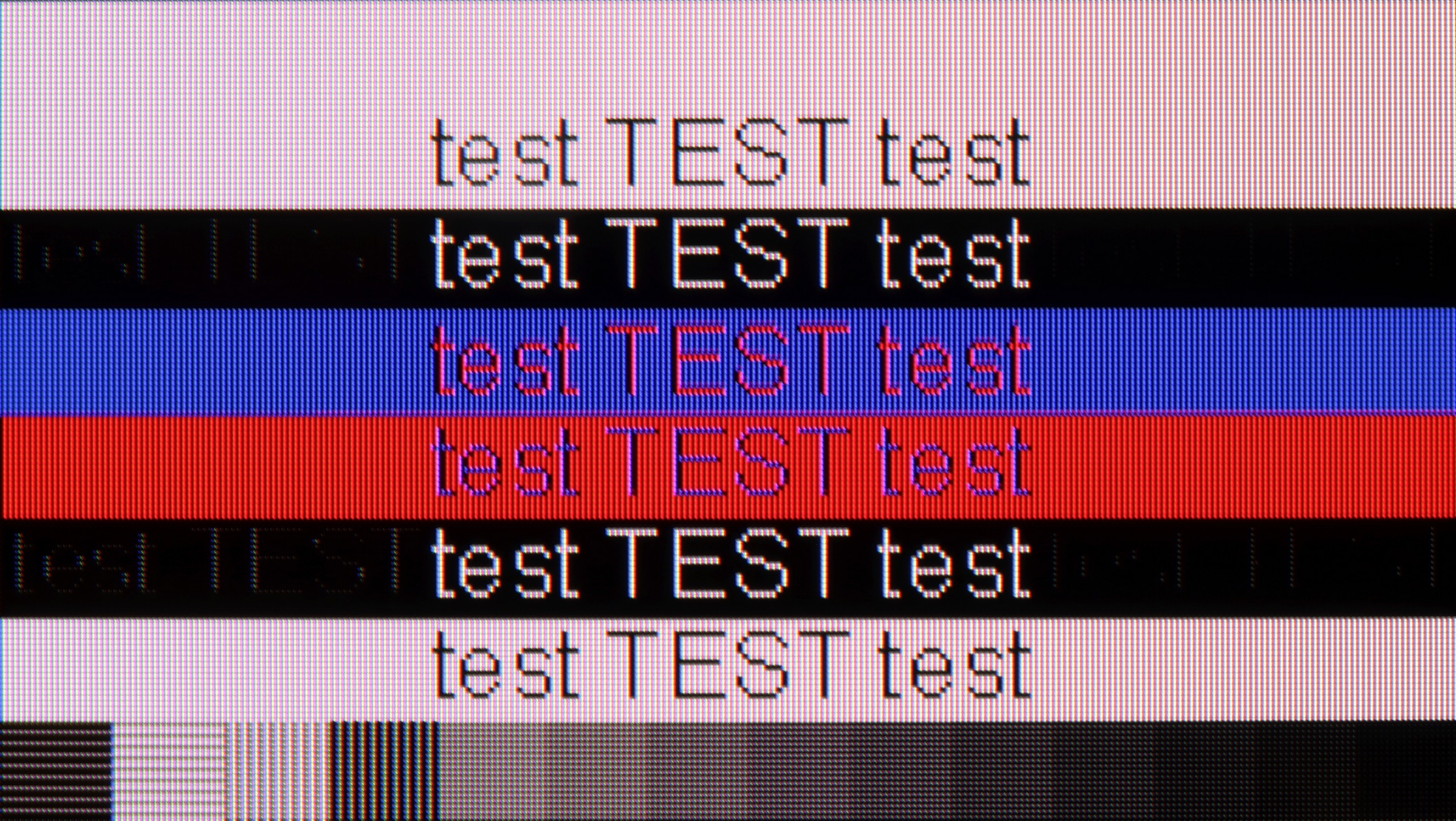
Samsung QN900D offers very good compatibility with computers, making it an excellent choice for users looking for a large screen for work and entertainment. It supports full colour reproduction with Chroma 4:4:4, resulting in better image quality when using text and office applications. The readability of fonts is quite good, especially considering the 8K resolution, which offers an enormous level of detail.
Unfortunately, despite the very high resolution, the television has some issues with bright fonts on a dark background – slight shadows created by subpixels can be noticed. This may not be a key issue, but for more demanding users, it could affect the comfort of use, particularly when working in text applications. Nevertheless, the overall image quality and compatibility with computers are at a high level. It is also worth praising the television for supporting 240Hz at lower resolutions like 4K. This allows high-end PCs to showcase their prowess in gaming.
The QN85F performs really well in terms of cooperation with a computer. Thanks to the PC mode with a refresh rate of up to 144 Hz, support for G-Sync, and low input lag, playing on a personal computer is very enjoyable and shouldn't cause irritation even for more demanding gamers. The readability of the fonts is also good – the television supports chroma 4:4:4, so standard texts look sharp and clear. The problem arises only with very thin letters. Regardless of the refresh rate setting – whether it's 144, 120, or 60 Hz – horizontal, thin lines were poorly visible. Reducing the refresh rate slightly improved the situation, but never enough to say that they were displayed perfectly.
Viewing angles
7.8/10
3.2/10
The viewing angles on the QN900D television are very good, despite the use of a VA panel. Thanks to a special coating that broadens the viewing angles, the picture remains flawless even when viewed at an angle. This is particularly important when there are more people in the room – every viewer, regardless of their seating position, can enjoy excellent picture quality, without distortion or loss of colours. This makes the Samsung QN900D a great choice for watching both films and sports broadcasts with a larger group.
The viewing angles on the QN85F are the classic Achilles' heel of most LCD televisions with VA panels. Looking at the screen from an angle, the drop in brightness becomes noticeable quite quickly, the whites start to grey, and the colours lose their intensity. This is the price to pay for the high contrast that this technology offers. Samsung could have included a better coating to widen the viewing angles in this model, but it is not present here. In practice, this means that the best viewing experience is achieved when sitting directly in front of the television, and any significant deviation will result in a noticeable loss of image quality.
TV efficiency during daytime
5/10
6.9/10

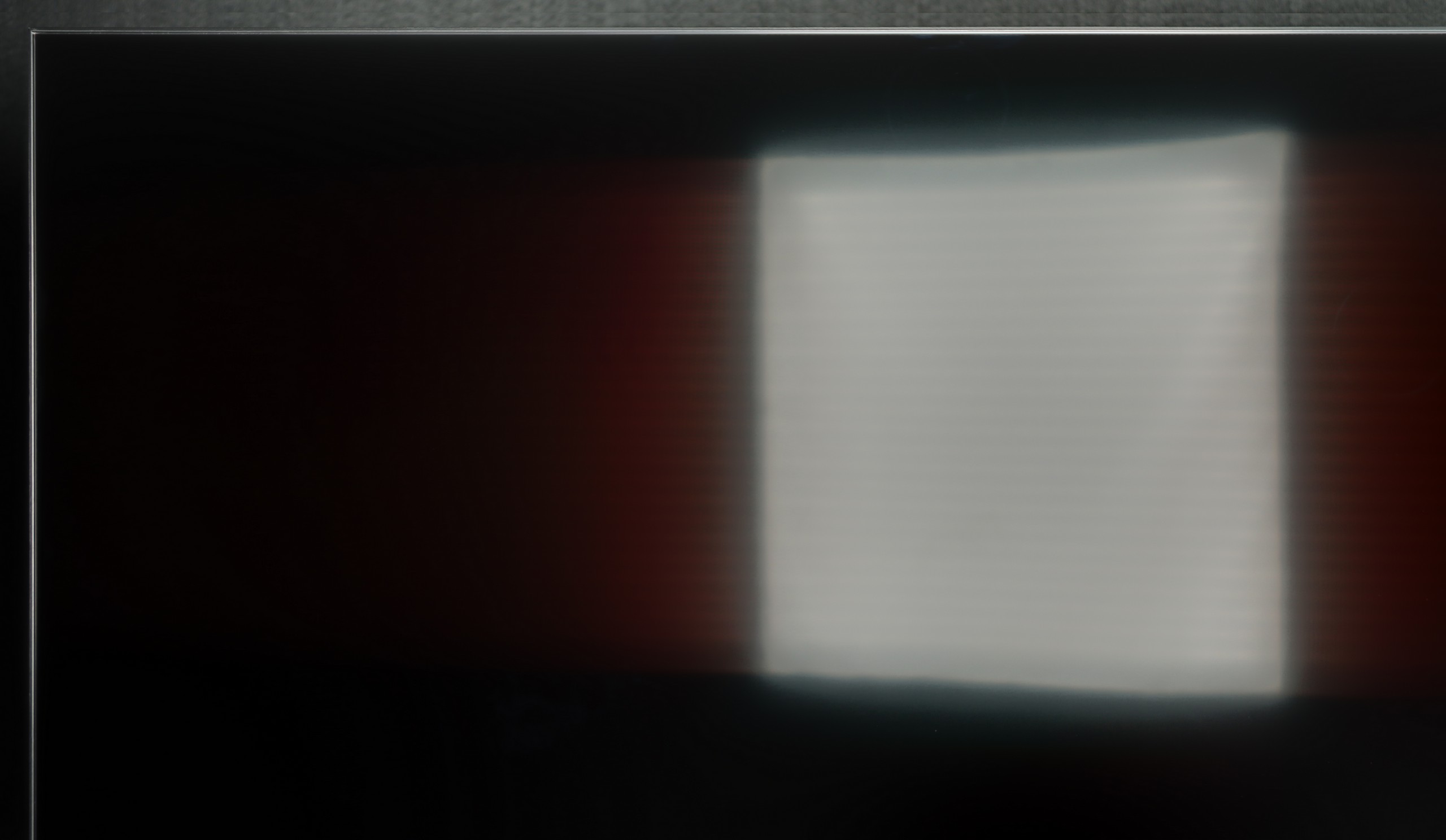


Matrix brightness
Average luminance SDR
Samsung QN85F : 690 cd/m2
Samsung QN900D Neo QLED 8K: 387 cd/m2
When it comes to the performance of the Samsung QN900D television in daylight conditions, it is generally average. The television has a special anti-reflective coating that helps reduce glare; however, due to the VA panel and the layer that widens the viewing angles, light reflections are heavily scattered horizontally - resembling the colours of a rainbow. This results in a loss of image vibrancy, especially in bright rooms where intense light sources can negatively affect the quality of the displayed image.
The QN85F performs excellently during the day. The satin finish of the panel combined with high brightness makes it a television designed for bright rooms. Colours do not lose their intensity, and the picture does not fade even when a lot of light enters. The television itself is bright enough to handle a living room with large south-facing windows without any issues. Therefore, the QN85F provides us with an image that allows us to watch films or matches during the day without annoying reflections and the feeling that the picture disappears in the sunlight.
Details about the matrix
Subpixel Structure:

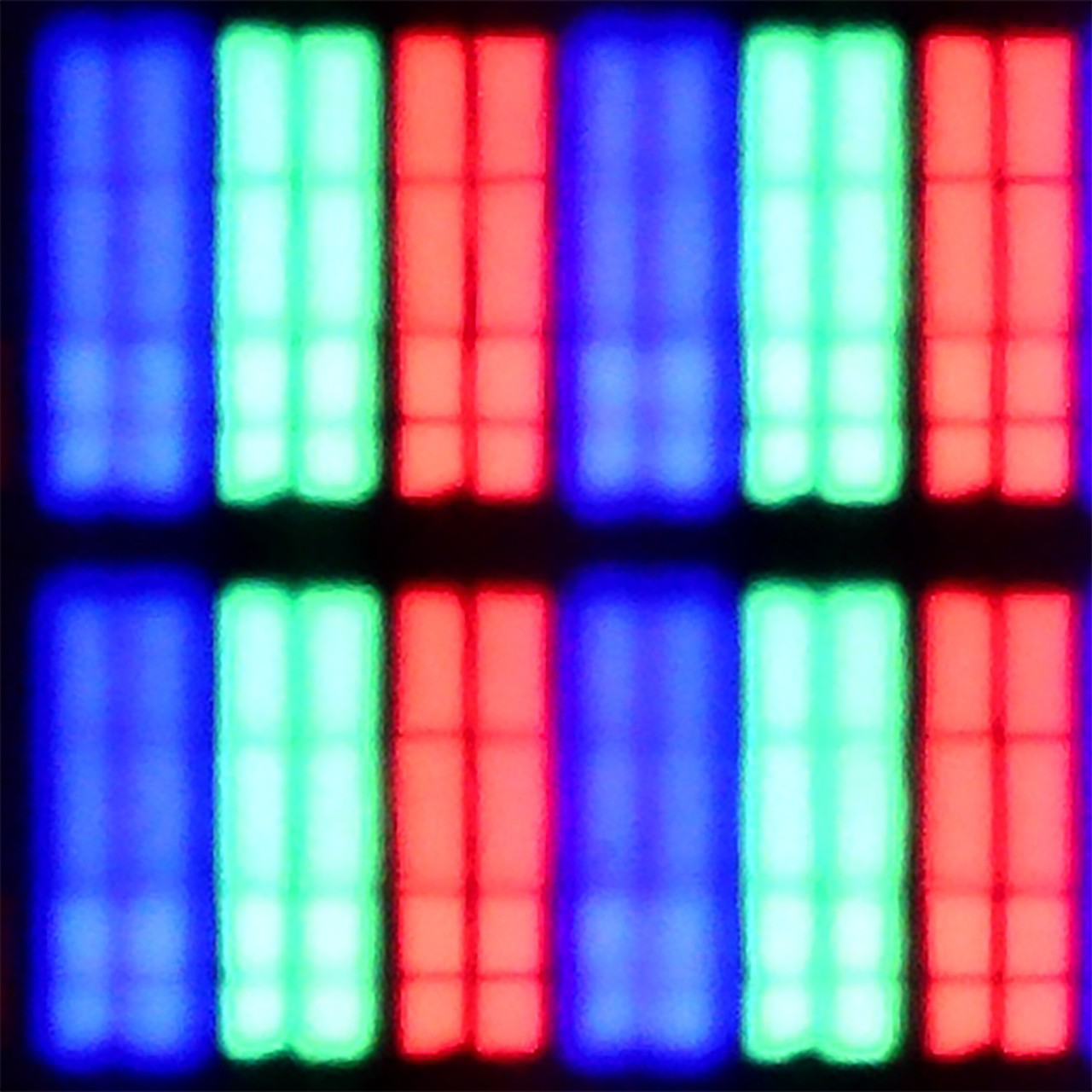
Panel uniformity and thermal imaging:


Samsung QN900D Neo QLED 8K
Samsung QN85F
TV features
7.4/10
7.3/10
- HDMI inputs0 x HDMI 2.0, 4 x HDMI 2.1 40Gbps0 x HDMI 2.0, 4 x HDMI 2.1 48Gbps
- OutputsToslink (Optical audio), eARC (HDMI), ARC (HDMI)Toslink (Optical audio), eARC (HDMI), ARC (HDMI)
- Network InterfacesWi-Fi 2.4GHz, Wi-Fi 5GHz, Ethernet (LAN) 100MbpsWi-Fi 2.4GHz, Wi-Fi 5GHz, Ethernet (LAN) 100Mbps
- TV receptionDVB-T, DVB-T2, DVB-S, DVB-S2, DVB-CDVB-T, DVB-T2, DVB-S, DVB-S2, DVB-C
Classic features:
- Recording to USB (terrestrial TV)
- Recording programming
- Picture in Picture (PiP)
- RF remote control (no need to aim at the screen)
- Backlit remote control
- Teletext
- Audio only mode
- Bluetooth headphones support
- Simultaneous Bluetooth headphones & TV audio
Smart features:
- AirPlay
- Screen mirroring (Windows Miracast)
- Voice search
- Voice search in native language
- Ability to connect a keyboard and mouse


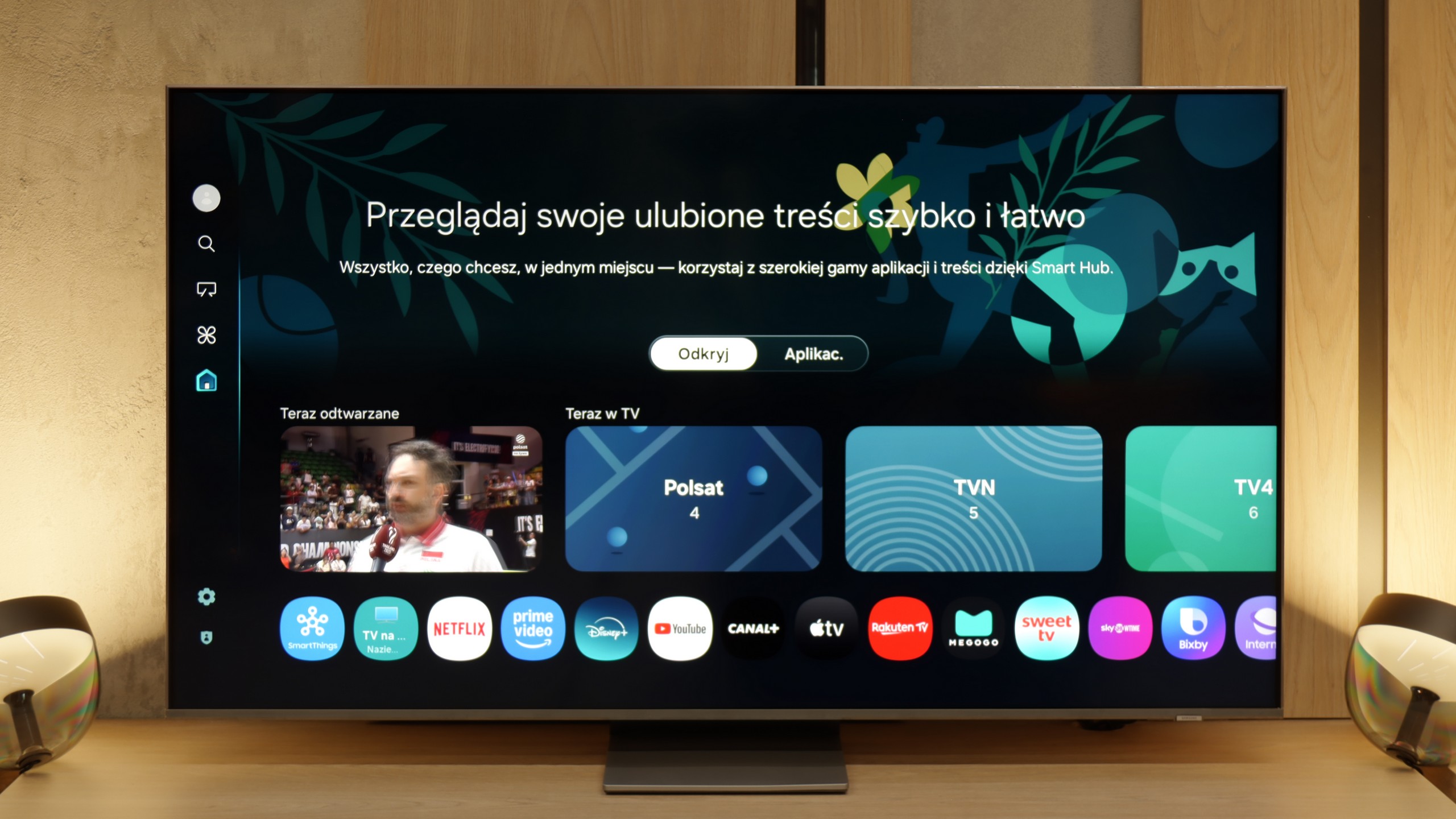
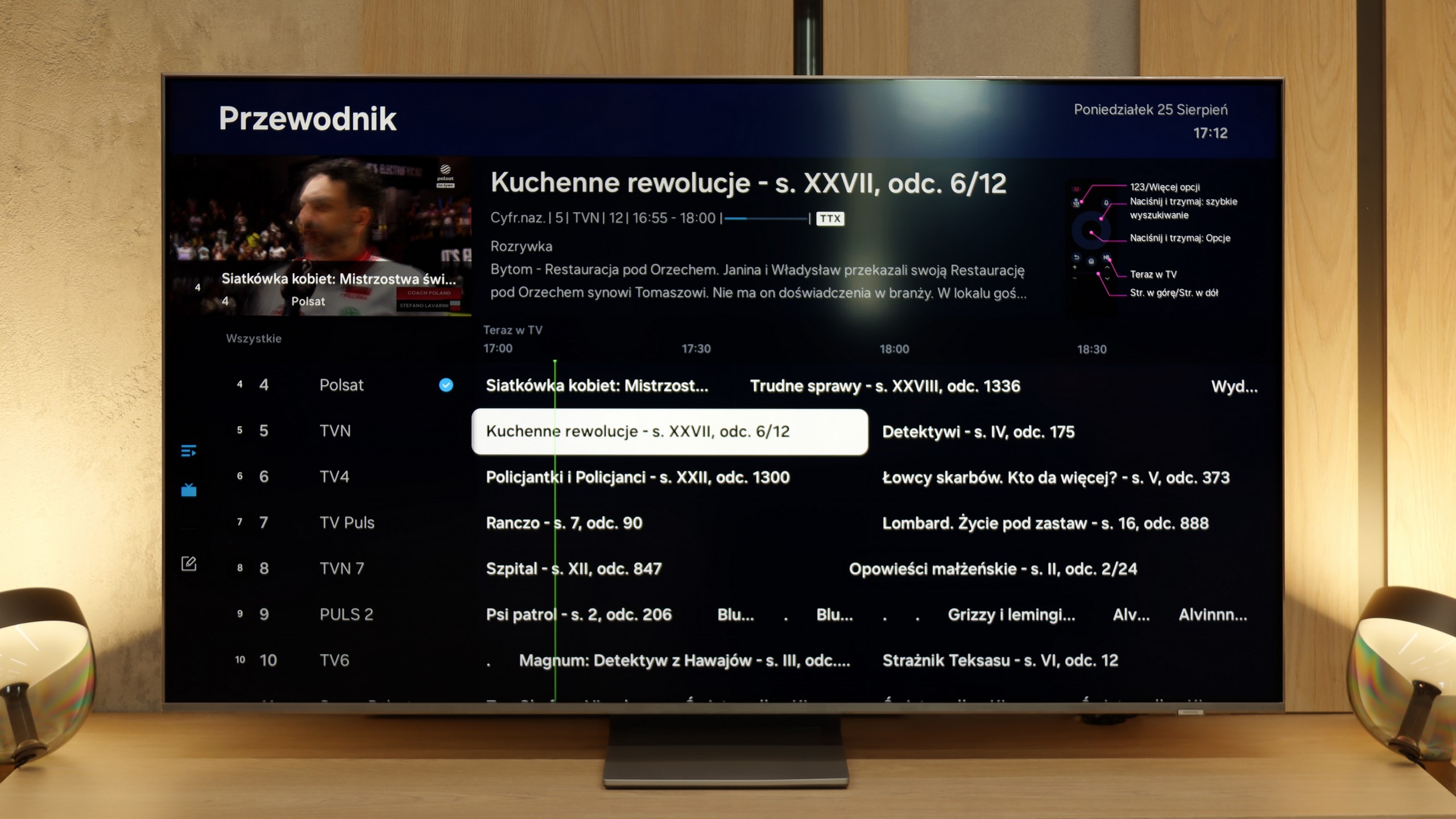
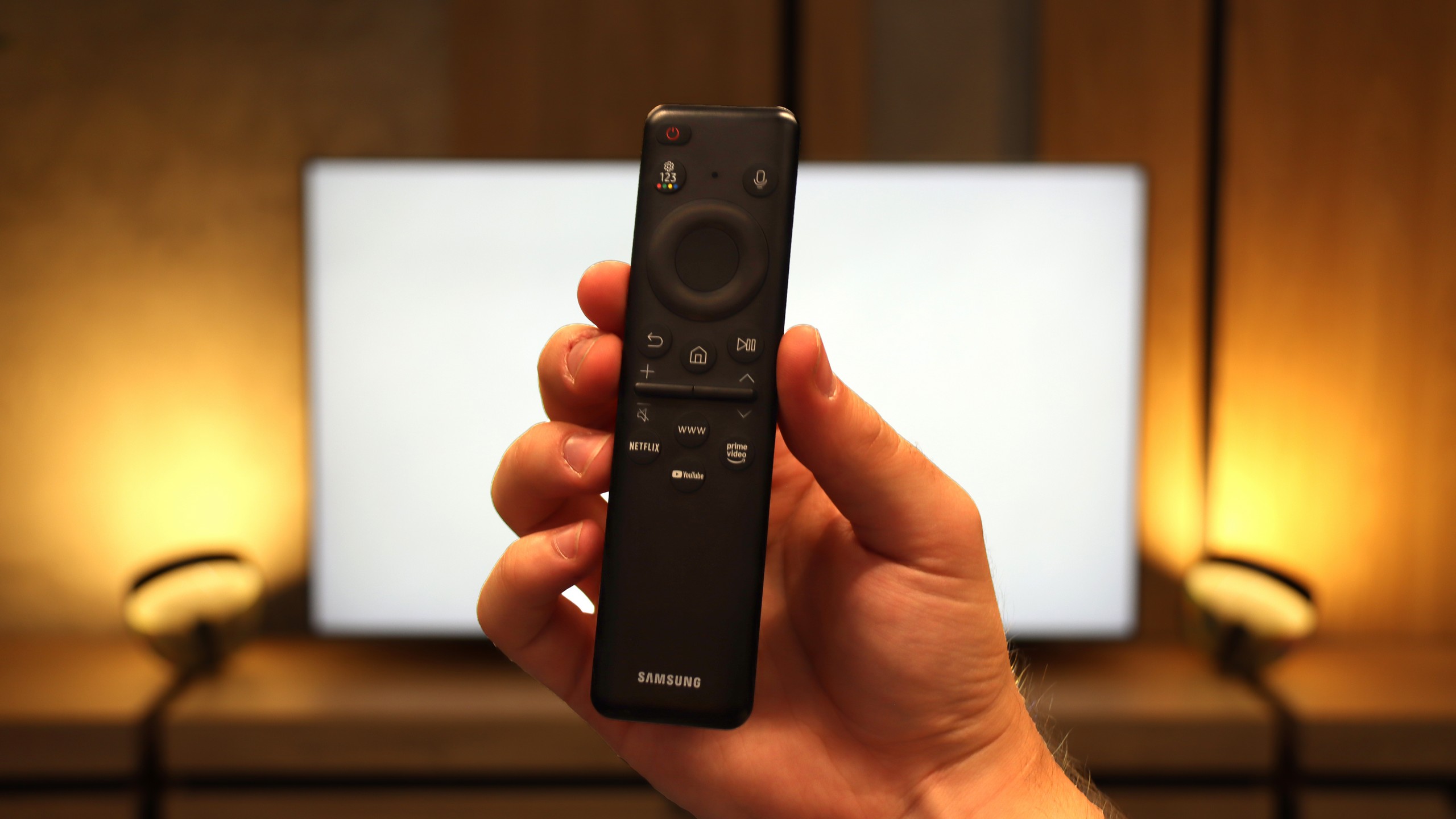
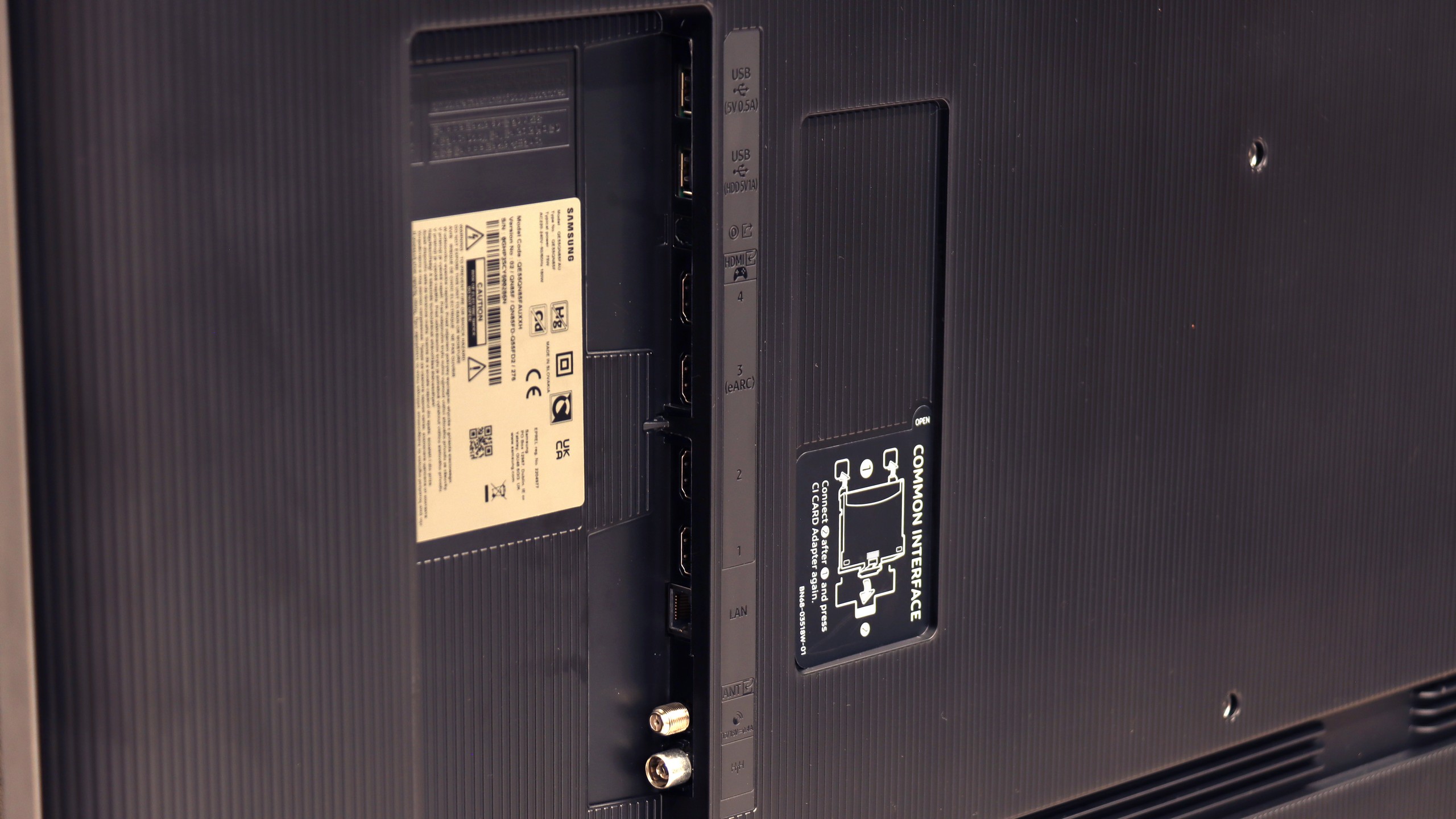
The Tizen system that powers the Samsung QN900D television offers excellent integration with other devices, allowing for convenient use of numerous applications, including AirPlay. Users also have the option to control other equipment via the SmartThings app. The television also works with lighting systems such as Philips Hue, enabling the creation of a moody atmosphere during film screenings.
In everyday use, the QN900D performs exceptionally well. The solar remote can control other devices, such as set-top boxes, making the lack of recording functionality less of an issue. Additionally, the television features a Picture-in-Picture (PiP) function, and with its 8K resolution, it is even possible to split the screen into four parts, making it exceptionally functional and useful for watching multiple programmes simultaneously as well as for effective work with various image sources.
The Samsung QN900D also stands out with its modern appearance. Its slim profile makes it the thinnest Mini LED television on the market, and the use of the One Connect module allows for neat cable management, so the area around the television looks tidy and elegant. The central stand adds lightness and creates the impression that the television is floating in the air, giving it a unique character. Additionally, the Ambient Mode feature allows for the display of decorative graphics or the adjustment of the image to fit the interior, making the television an integral part of the room, even when it is switched off.
Smart TV and Tizen System
The Samsung QN85F runs on the proprietary Tizen operating system, which has been one of the strongest points of the Korean manufacturer for years. The platform operates quickly, is well-developed, and provides access to virtually all necessary applications. It supports AirPlay, allows screen mirroring, voice search, and has a very clear interface. It is all controlled by a remote with a minimal number of buttons, designed for quick access to the most important applications.
Classic TV Features
In terms of classic television functions, the QN85F offers a rather basic set. The EPG interface is readable and easy to use, resembling a traditional teletext programme list. A drawback is the lack of USB recording and the absence of PiP functionality, which Samsung has offered in many other models. This is due to the use of single tuners in the QN85F. For some, this may be a disadvantage, but considering how few viewers today use traditional linear television, it may not matter much to the majority of users.
SmartThings and Device Support
A strong element of the entire platform is the SmartThings application. Thanks to it, we can integrate the television with other home devices – not just those from Samsung. We can connect smart lighting such as Philips Hue or Yeelight, video doorbells, and many other devices to the system. SmartThings also allows us to control the television without using a traditional remote – we can use the app on a smartphone, mouse mode, or gesture control if we have a Samsung watch. This makes the QN85F part of a larger ecosystem and fits perfectly into the smart home IoT trend.
Playing files from USB
9.2/10
9.1/10
Supported photo formats:
Maximum photo resolution:

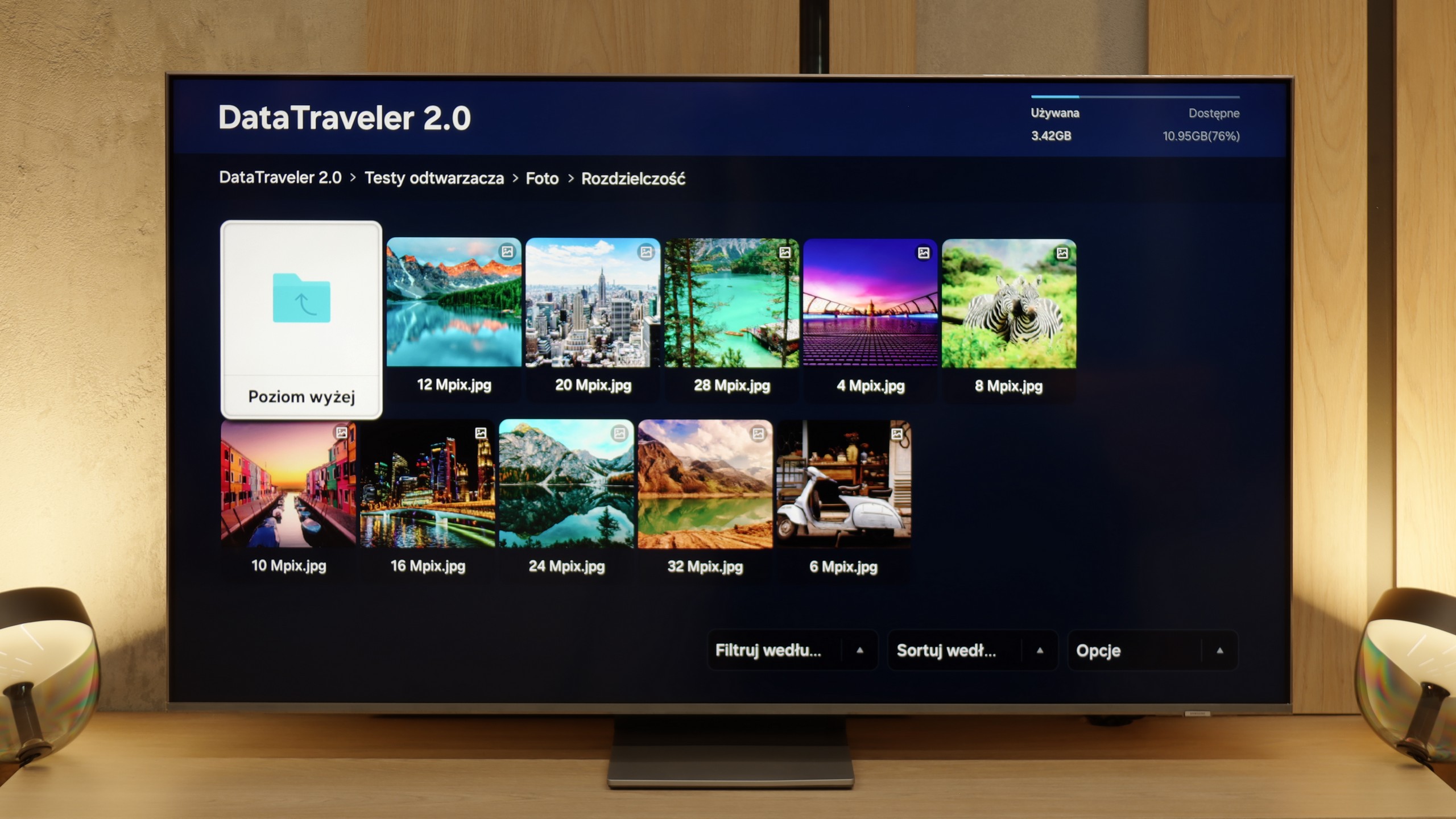
QN900D Samsung plays most popular video and audio formats without any issues. The resolution of images is also not a challenge for it; however, the television has difficulty opening less common image formats, including Apple's HEIC format.
The player in the QN85F works as most people expect; it supports practically all popular formats and is more than sufficient for even the more demanding users. Movies, music, photos – everything runs smoothly. The only hiccup occurs with HEIC files, which are photos from Apple devices. According to the specifications, they should work, but in practice, they simply do not open. Thumbnails are visible, but the file refuses to launch. This seems to be a common software glitch. Aside from that one issue, the player performs well and does not give rise to complaints.
Apps
8.7/10
8.7/10














































Sound
7.4/10
7.6/10
- Maximum volume-84dB
- Dolby Digital Plus 7.1
- Dolby True HD 7.1
- Dolby Atmos in Dolby Digital Plus (JOC)
- Dolby Atmos in Dolby True HD
- DTS:X in DTS-HD MA
- DTS-HD Master Audio
Television Samsung QN900D, equipped with an audio system with a power of 90 W in a 6.2.4 channel configuration. Despite its slim casing, the sound is clear and spacious, which is further supported by Dolby Atmos technology, providing immersive audio experiences. Unfortunately, like many other Samsung televisions, the QN900D does not support audio tracks in DTS format, which may be significant for home cinema users.
The Samsung QN85F is equipped with a 2.2 system with a power of 40 W, and when it comes to built-in speakers, it performs really well. The bass is pleasant, and the dialogues are clear and easily heard even during louder scenes. Even at maximum volume, the television does not produce any unwanted vibrations and nothing crackles. At the bottom of the casing, there is a subwoofer responsible for the bass – therefore, when installing, it is worth ensuring that it is not obstructed by anything.
As for formats, the QN85F does not support DTS:X audio, which has been a standard from Samsung for several years now, forcing Blu-ray enthusiasts to connect audio devices first to the home cinema and then to the television. However, in return, we receive support for the more popular Dolby Atmos format, which can add additional space to sound in films and series.
Acoustic Measurements
No acoustic data
84dBC (Max)
75dBC


